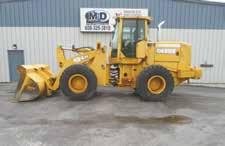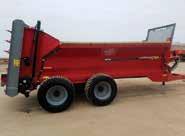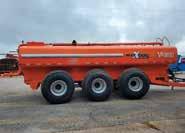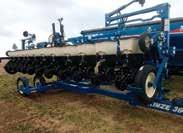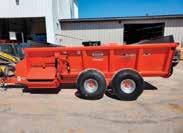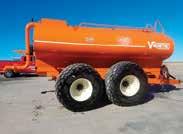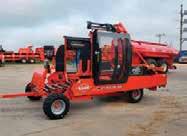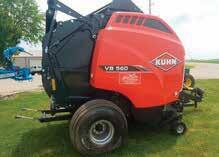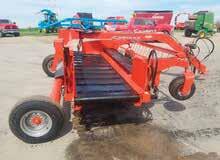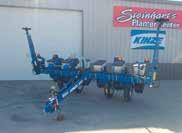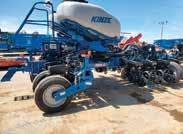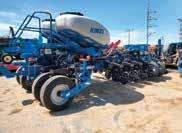See pages 24 and 25 of this section for details!
“All

See pages 24 and 25 of this section for details!
“All
Using carbon footprint, credits to capitalize on sustainability efforts
By Danielle Nauman danielle.n@dairystar.com
ATHENS, Wis. — Dairy farming in the 21st century can be complex, and understanding what it means to be sustainable, and how to achieve it, is paramount.
Farmers knowing their carbon footprint number and understanding carbon credits to capitalize on sustainability efforts were explained at the Professional Dairy Producers’ “Carbon, Crops and Cows” workshop Nov. 12 at Miltrim Farms Inc., near Athens.

Carson
Dugger Lead Agronomist Eocene Environmental Group
“For years we have been hearing from our European counterparts about how sustainable they are because they have a carbon footprint number,” said Shelly Mayer, executive director of PDP. “The U.S. dairy farmer is leaps and bounds ahead — the most sustainable — but we need to know that number to be able to make that claim. If you can’t measure it, you can’t manage it.”
In response to the global drive towards sustainability, Mayer shared that PDP has developed Your Farm — Your Footprint, a farmer-led sustainability initiative aimed at empowering dairy producers to understand their environmental footprint and assist them in implementing solutions to help shape the future of their farm.
Lead agronomist Carson Dug-
By Dan Wacker dan.w@dairystar.com
SPRING GREEN, Wis. — Agriculturalists Pieter and Lynn Verhoef have dairy farmed on two continents: Europe and North America. Growing up on a dairy farm, Pieter said he always had a passion for the dairy industry. That passion has taken him and his family around the globe, and they now operate a dairy in Spring Green where they milk 300 cows. Pieter grew up in the Netherlands on his family’s dairy farm near Lopik and went on to work as a professional diesel mechanic.
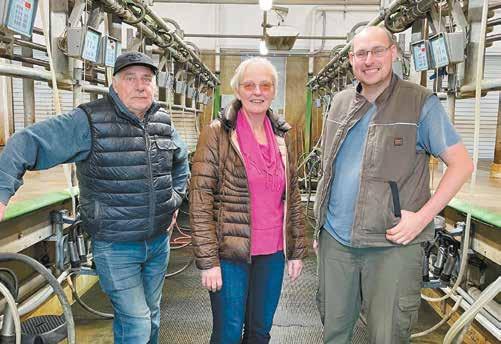

By Stacey Smart stacey.s@dairystar.com
The farm is committed to proactively pursuing environmentally responsible practices that are gentle on the environment and positive for protability. As a result of their efforts, Double S Dairy received the 2024 National Dairy Farmers Assuring Responsible Management Program Excellence Award in Environmental Stewardship. The team at Double S Dairy, which milks 1,500 cows near Markesan, employs a full-circle approach to environmental stewardship that is founded on a belief
Published by Star Publications LLC
General Manager/Editor
Mark Klaphake - mark.k@dairystar.com
320-352-6303 (ofce) 320-248-3196 (cell) 320-352-0062 (home) Ad Composition - 320-352-6303
Nancy Powell • nancy.p@dairystar.com
Karen Knoblach • karen.k@star-pub.com
Annika Gunderson • annika@star-pub.com
Cheyenne Middendorf • cheyenne@star-pub.com
Nadiia Griepentrog • nadiia@star-pub.com
Editorial Staff
Stacey Smart - Assistant Editor 262-442-6666 • stacey.s@dairystar.com
Danielle Nauman - Staff Writer 608-487-1101 • danielle.n@dairystar.com
Dan Wacker - Staff Writer 608-487-3858 • dan.w@dairystar.com
Tiffany Klaphake - Staff Writer 320-352-6303 • tiffany.k@dairystar.com
Amy Kyllo - Staff Writer amy.k@star-pub.com
Emily Breth - Staff Writer emily.b@star-pub.com
Sarah Middendorf - Staff Writer sarah.m@star-pub.com
Advertising Sales
Main Ofce: 320-352-6303 Fax: 320-352-5647
Deadline is 5 p.m. of the Friday the week before publication
Sales Manager - Joyce Frericks 320-352-6303 • joyce@saukherald.com
National Sales Manager - Laura Seljan (National Advertising, SE MN) 507-250-2217 • fax: 507-634-4413 laura.s@dairystar.com
Assistant Sales Manager - Kati Schafer (Northeast WI and Upper MI) 920-979-5284 • kati.s@dairystar.com
Adam McClary (SW MN, NW Iowa, South Dakota) 605-951-5270 • adam.m@dairystar.com
Mike Schafer (Central, South Central MN) 320-894-7825 • mike.s@dairystar.com
Hannah Ullom (Western Wisconsin) 715-933-4045 • hannah.u@dairystar.com
Julia Merten (Southeast MN and Northeast IA) 507-438-7739 • julia.m@star-pub.com
Bob Leukam (Northern MN, East Central MN) 320-260-1248 (cell) bob.l@star-pub.com
Mark Klaphake (Western MN) 320-352-6303 (ofce) • 320-248-3196 (cell)
ger and technical services manager
Courtney Titus of Eocene Environmental Group explained how dairy farmers understanding the science and learning their farm’s carbon footprint number can create opportunities for their dairy.
“We’re looking at what we can control and manage to start to reduce those scores,” Titus said. Dugger explained there are multiple ways to measure carbon impact on a farm. The farm’s carbon footprint can be calculated by determining the amount of greenhouse gas emissions released into the atmosphere through activities on the farm. Carbon intensity is measured by the amount of carbon created per unit of production.
bon intensity score decreases.”
Both carbon and nitrogen cycles play a role in how greenhouse gases are emitted into the atmosphere. Understanding both can improve carbon management on the farm, Dugger said.
One
tion versus the amount released back into the air plays a role in determining the carbon footprint.
Soil organic carbon is the most stable form of carbon. It is benecial not only to the soil, but to the farm’s overall carbon footprint.






The three main greenhouse gases that typically result from dairy production are methane, nitrous oxide and carbon dioxide.

“Methane is one we hear a lot about, with enteric emissions that dairy and beef get a pretty bad rap for,” Dugger said. “Methane is considered short-lived in the atmosphere because over time it degrades down into carbon dioxide and eventually goes back into the soil.”
To determine a farm’s carbon footprint score, Titus said emissions are considered from “cradle to farm gate,” meaning that once the product leaves the farm, further transportation and processing for that product are not included in the farm’s carbon footprint.
“The scope is what you’re trying to measure,” Titus said. “While the boundary is looking at where is this emission happening and what is its impact.”
“The carbon footprint reects more long-term change,” Dugger said. “Carbon intensity is easy to impact on-farm by increasing efciency, doing more with less. Ultimately, we’re looking at greenhouse gas emissions, and if we have less total GHG emissions per product, our car-
Conversely, Dugger said nitrous oxide is worse because it is longer lived in the atmosphere and has greater potential for global warming.
During the photosynthesis process, plants remove carbon dioxide from the air, turning it into plant material. The amount of carbon captured in the soil through carbon sequestra-
Emissions used to develop a carbon footprint score are categorized as Scope 1, which are direct emissions, and Scope 2 and 3, which are indirect emissions created by either upstream or downstream activities.
Scope 1 emissions include fuel usage and enteric methane emissions.















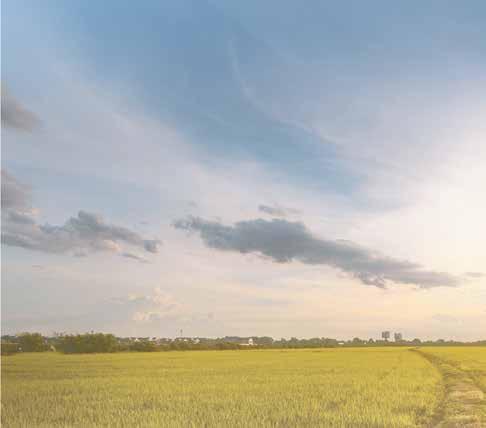

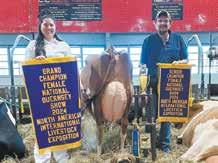


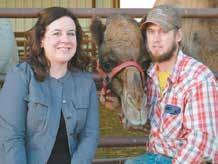


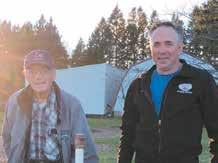



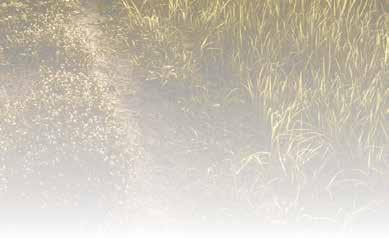
























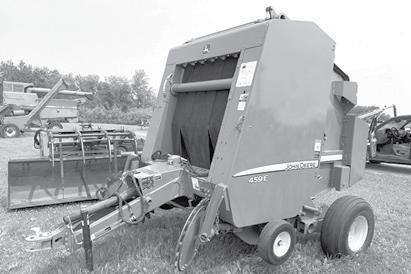
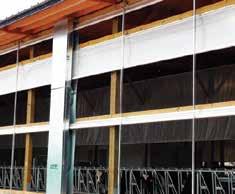

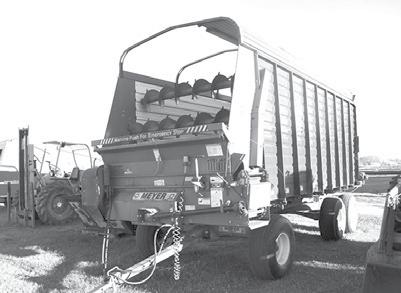




Determining a farm’s carbon footprint involves the collection and analysis of data, which is run through three models to determine a baseline number. Using that information, dairy producers can look within their farms to nd avenues to increase efciencies and decrease their footprint score.
“We want to get as detailed as possible so we can avoid overestimating,” Titus said. “When you get into Scope 3, it is very hard to gather data.”
Many farms are most interested in Scope 1 and 2 Titus said.
Eocene’s function is to visit the farm, collect information, and run it through their models, creating a baseline carbon number. A year later, the same data is collected again, allowing for comparisons to determine where carbon reduction has been recognized.
Once a reduction from the baseline has been realized, the option exists for dairy farmers to enter the carbon market. There are two types of carbon markets in place — regulatory and voluntary.
“Most of the carbon markets we’re participating today in the U.S.
are voluntary markets,” Titus said. “With carbon credits and carbon markets, verication is required. They are looking for quantication of a baseline and they are looking for implementation — what did you do to improve?”
Entering the carbon marketplace can allow dairy farmers to create revenue from their efforts to reduce their carbon footprint. Titus cautions farmers to remember that once they sell a carbon credit, they can no longer claim that towards their farm’s overall carbon footprint score, as it will factor into the purchasing entity’s score.
Grasping the opportunity to create an individual path towards sustainability is something Mayer urges dairy farmers to pursue.
“As dairy farmers, nding your voice and knowing your business is more important today than it has ever been,” Mayer said. “If we’re going to have a market, we’re going to have to stand up proactively and continue to share our story. We can complain as much as we want about consumers and the retail chain, but we’re all connected.”



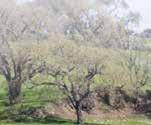
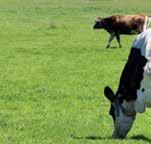


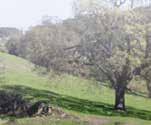
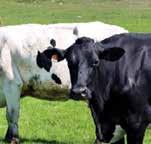


The Dairy Star is sent only to DAIRY FARMERS! If you would like to advertise in the DAIRY STAR, call 320-352-6303 for more information.






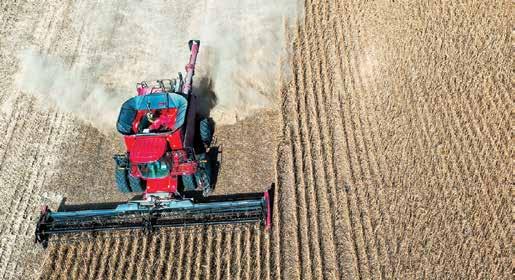

















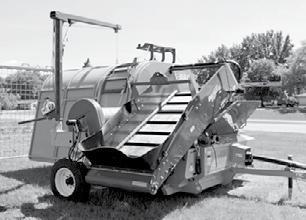

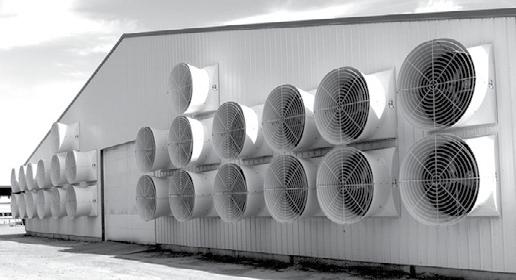
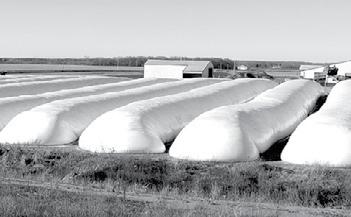








Pieter (from le ), Lynn and Yannic Verhoef stand Nov. 7 by their corn
pile on their farm near Spring Green, Wisconsin. The Verhoefs milked 40 cows in France and moved to the U.S. in 2012 so they could expand. meeting our quota.”
After a decade of xing tractors and heavy machinery, Pieter wanted to get out from under the hood.





To make his dream a reality, he and Lynn found two neighboring farms about 450 miles from home in the Mayenne region of France. After arriving in France, the Verhoef’s provided modern touches to their new dairy.
“We built a 50-stall freestall barn and built a new house,” Lynn said. “There we milked in a double-5 parlor.”
Though the Verhoefs had made their dream a reality, the French milk market had them capped at milking 40 cows.
“When we rst started milking in France, we had a quota of 350,000 liters a year,” Pieter said. “That totals about 47 cows. If the cows give more milk and you exceeded your quota, you had to get rid of some cows. So even though we built a 50-cow freestall barn, we were never allowed to ll it all the way because our cows gave more milk and our herd kept
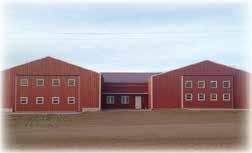
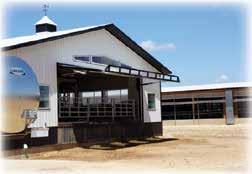
In 2012, Pieter and Lynn decided to move in order to build a dairy how they wanted to.
“If you’re at a standstill, you’re moving backwards, so I’ve always tried to push us forward,” Pieter said. With expansion on their mind, the Verhoefs sold their farm in France and purchased their farm in Wisconsin. This time the family moved over 4,000 miles to their new home to establish Verhoef Farm LLC.
Pieter and Lynn, along with two of their sons, Pascal and Yannic, brought two tractors, an excavator and parlor equipment with them to continue expanding and improving their new dairy.
“We had a choice between Canada and here, and Pieter has always had a liking to this area,” Lynn said. “Canada was also doing the quota system, so it was difcult to get started there.”

After farming the same number of cows in France for two decades, Pieter and Lynn wanted a chance to expand their herd and build up a dairy. After milking in a stanchion barn for a year, Yannic suggested they go back to a parlor.
“We (had already) bought the parlor equipment from another French farmer before moving to the States,” Pieter said. “We took it out, cleaned it, shipped it over here and installed it.”
They milk their herd with two employees.
“It truly takes a village,” Lynn said, “We are thankful for all the good employees and people we have associated with our dairy. We can’t do it alone, and this group of people helps make that possible.”
Improving their dairy continues. The Verhoefs added a second freestall barn in two parts, with Pieter doing the electrical and plumbing work. The rst stage of the barn was built for dry cows on water beds, with a straw-bedded pen for calving. Two years later, it was expanded for calves and heifers to all be under the same roof. Pieter and Lynn also converted their old tiestall milking barn into pens for youngstock.
“I’ve always been a build-
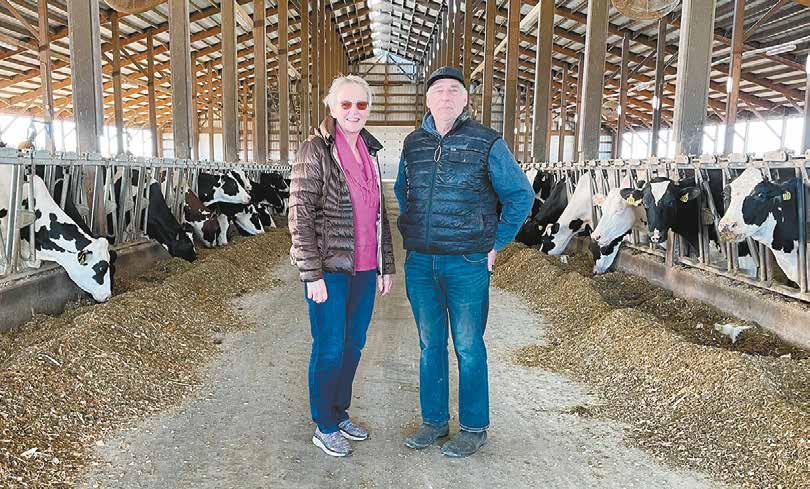
Lynn and Pieter Verhoef stand in the feed alley of their freestall barn Nov.
have added the
er,” Pieter said. “I like continuing to build things up so they work better and easier. We’re always looking to improve.”
The Verhoefs said they
are uncertain how much bigger they want to be. The dairy averages 77.8 pounds of milk per cow per day, with tests of 4.3% butterfat and 3.4% protein.
“You never know what will happen in the next ve years,” Pieter said. “Now we are looking more at what Yannic and Pascal will be wanting out of the farm.”
Yannic is working on the farm and Pascal is attending the University of WisconsinRiver Falls Farm and Industry Short Course with plans to return to the farm.





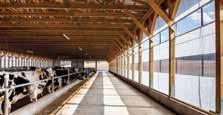












in doing their part to preserve what has been given to them.
“We’re called to be stewards of God’s creation,” Adam Franken said. “All of us here have a passion for agriculture. We love the seasonality of growing crops and seeing how crops work with the cattle. It all blends together as we take care of what we’re given. Our sustainability practices t with that and help our farm to be protable as well.”
Double S Dairy is owned by Dan and Steve Smits. Joining the brothers on the management team are Dan’s son, David Smits; Steve’s sons-in-law, Adam Franken and Drew Buiter; Butch Guenther, Mike Perry, Kyle Ter Beest, Ridge Grams, Cal Loomans, and the Smits’ brother, Mark, who is manager and part owner of the farm’s heifer ranch.
In addition, Dr. Monty Belmer of Waupun Veterinary Service has worked with the herd for 37 years, and Bob Hagenow has served as the dairy’s nutritionist for 32 years.
“Double S Dairy operates with a complete sustainability mindset,” Hagenow said. “They are very good stewards of the natural resources they have been given to work with, and their management practices have proven to be sustainable in the true sense of the word.”
The rst-generation farm was purchased by the Smits in 1993. Dan and Steve started in a tiestall barn before building a 220-cow freestall facility and milking parlor. Eighteen years ago, the Smits purchased another farm for raising heifers.
Cows are housed in three freestall barns, all of which have undergone expansions along with the milking parlor. The newest barn, built in 2016, is an 8-row cross-ventilated building hous-

S Dairy
ing 800 cows. Cows are bedded with manure solids made by a composter.
Cows are milked three times a day in a double-20 parallel parlor. The team monitors milk production, watching pounds of milk produced per day, as well as butterfat, protein and conductivity.
Sustainability efforts are translating into higher production, as cows recently hit record highs for performance, reaching 112.9 pounds of energy-corrected milk and 7.6 pounds of combined fat and protein. Guenther said it is homebred cows producing these numbers.
“Through the use of technology and genomics, we’re improving the quality
of our herd exponentially,” he said.
Environmental stewardship is ingrained in the culture at Double S Dairy from top to bottom. Every employee at Double S Dairy is committed to, and contributes to, the farm’s mission of farming sustainably.
“Everyone here is on the same page,” Hagenow said. “They know the farm’s objectives and next opportunities.”
Weekly management meetings taking place for over 30 years are a big contributor to the farm’s success, Hagenow said.
“Everyone comes together intentionally to report, see opportunities, and painstakingly go over things that

are not going well to minimize trends or issues that could take us off track,” Hagenow said.
Team members are devoted to protecting and preserving the land on which they make their livelihood. Minimizing soil loss and maximizing nutrient retention is always a priority, the management team said.
“Our focus on efciency on the crop side comes through in pretty much everything we do,” said Perry, the farm’s crop manager. “We try to be good stewards of the land and utilize cover crops whenever possible. Our alfalfa has cover all the time, and silage ground goes into cover crop after harvest.”




Their planter is equipped with variable rate seeding and fertilizing. The planter utilizes row shut-offs to minimize fertilizer and seed waste and applies fertilizer in furrow, to ensure application only where needed. Perry said the farm also utilizes Y-drops to band fertilizer next to the row in season, which reduces the amount needed.
“We’ve invested heavily in technology on the planter and fertilizer applicators to ensure we put things exactly where they need to be,” he said. “There is no overlap.”
The dairy utilizes a GPS system that features maps for every eld, which further reduces waste when applying seed and fertilizer. The farm uses minimal tillage practices to minimize erosion while maintaining standards for manure application. Several years ago, they installed two miles of long-range, underground piping to minimize road trafc and dust when spreading manure.
“The team here pays incredible attention to manure and manure nutrients
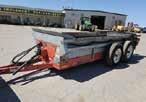


being placed in the right crop at the right time for maximum utilization,”
Hagenow said. “They’re very conscious of making sure it’s applied correctly with good knowledge of where neighbors and roads are. They maximize the amount used without infringing on anyone else.”
A 360 RAIN system uses a combination of leachate collection water, well water and manure to precisely irrigate elds at Double S Dairy.
“This system allows us to apply water and manure on crops in season in the row as the crop needs it, when it needs it,” Franken said.
The farm’s collection system ensures every drop of dirty water is collected off the bunkers and feed pile and sent to a separate pit to be used for summertime irrigation.
In addition to corn, alfalfa and soybeans, the dairy grows vegetable crops for human consumption,

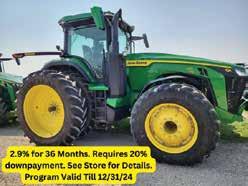




including sweet corn, green beans and peas.
The farm’s feed center serves as a point for storing and mixing feed indoors.
“The feed center allows for a very efcient feeding process,” said Ter Beest, the farm’s feed manager. “We keep feed out of the weather, and shrink is way down. We also premix feed to capitalize on feeding times.”
Ter Beest said they utilize feed bins for accuracy when adding ingredients to the mixer.
“Adding through an auger versus buckets removes human error,” he said. “Ingredients are in one spot making mixing time more consistent.”
Use of a feed software system helps ensure accurate mixing and feeding as well as efcient tracking of dry matter intake, feed efciency, ECM, moisture in the ration and more, Ter Beest said. Adjustments are made daily to maximize accuracy.
Prompt covering of feed and meticulous management of the face of the pile ensures minimal waste while preventing the release of volatile compounds into the air.
“We came from a basic understanding of sustainability, and like any other farmer, as we grew, we evolved in our sustainable focus,” Guenther said. “We keep track of our practices and stay on top of technology.”
Conservatively using resources for the fullest benet of their land and cattle has helped the team at Double S Dairy build a farm to stand the test of time.
“It’s a beautiful thing to see how God has created this cycle where animals take care of crops, and crops take care of animals,” Perry said. “We can be a part of that and facilitate it to be the best stewards of what we’ve been entrusted to. I think that’s important for our faith, the sustainability of the farm and for the next generation.”

“We














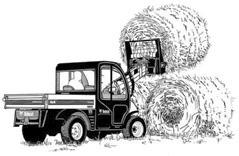


















The U.S. Department of Agriculture has issued a nal decision in its proposal to amend the uniform pricing formulas in all 11 Federal Milk Marketing Orders. The nal decision puts forth a package of amendments to update formulas and makes limited changes based on public comments. USDA Agricultural Marketing Service Deputy Administrator Dana Coale said the next steps are the most important. “This is where the dairy farmers get an opportunity to vote on each Federal Order as it has been amended through this nal decision. As soon as the nal decision is published in the federal register, we will begin the referendum process.” Every eligible dairy farmer or dairy cooperative will receive a ballot for each order where they have no pool. Ballots must be returned by Dec. 31. AMS will be hosting three webinars this month.
Ag secretary speculation underway
• Willmar, MN 320-235-3672 • 877-484-3211
810 Mayhew Lake Rd. NE • St. Cloud, MN 320-240-2085 • 844-262-2281 19612 US-71 • Long Prairie, MN 320-732-3715 • 866-514-0982


Farmers weigh unintended consequences
With a second Trump presidency, National Farmers Union President Rob Larew expects regulations to be ratcheted back. “We know that there’s going to be a large theme of regulatory reform and deregulation,” Larew said. “(To) a farmer that gets heavily regulated in a lot of ways, the idea of regulatory relief makes a lot of sense.” However, Larew wants to see a deliberate, thoughtful process. “We want to make sure that we don’t have unintended consequences by rolling back or closing ofces that could actually limit our options as farmers for innovative new products, new pesticides, new tools to make sure that we can be as successful as possible. It’s complicated. It needs to be done smart.”

By Don Wick Columnist Ag Insider
Veteran Washington analyst Jim Wiesemeyer is describing Donald Trump’s win as the greatest political comeback in history. Trump won all of the battleground states and expanded his broad support in rural areas. The speculation now begins over who will get the nod for Trump’s new cabinet. Numerous names are part of that guesswork for the agriculture secretary including former ambassador to the U.N. Agencies for Food and Agriculture, Kip Tom Tom is an Indiana farmer and co-chaired the “Farmers and Ranchers for Trump 47 Committee.” Other potential choices include Texas Agriculture Secretary Sid Miller, American Farm Bureau Federation President Zippy Duvall, former House Agriculture Committee Chairman Mike Conaway, former USDA Undersecretary Ted McKinney and former USDA Chief of Staff Ray Starling
Klobuchar wants farm bill before end of year Minnesota Senator Amy Klobuchar will serve as the Ranking Member of the Senate Agriculture Committee in the next session of Congress. During a stop at the Minnesota Ag and Food Summit, Klobuchar said she’d prefer to complete the farm bill before the beginning of the new year. “I just think we’re going to be better off when we’re doing all the disaster relief for the southern states and we’re doing that with good reason. There’s going to be funding that’s spent on that if the farm bill gets jettisoned as kind of an orphan at the end of next year. With an extension, it might be harder for us to get some of the resources that we want.” In addition to the farm bill, the 45Z tax credit guidance, year-round E15, and ex-fuel vehicles are on the to-do list. When an immigration bill is heard, Klobuchar also emphasized the need to address ag labor issues.
Economic relief likely, farm bill not University of Missouri Food and Agricultural Policy Research Institute Director Pat Westhoff is not optimistic that a new farm bill will be nished before the end of the year. “The fact that we haven’t been able to reach a compromise yet on the bill makes it difcult to imagine how we get the entire thing done during a short lame-duck session.” Westhoff believes there is more support for economic relief. “I do think the chance of some sort of economic assistance package is probably a bit higher,” Westhoff told Red River Farm Network. “Separate from a farm bill, a shorterterm bill that might actually provide some additional support to farmers might still be possible.”
Farm bill may be punted to ’25 Congress has a big to-do list during the lame-duck session. What does that mean for agriculture? “Honestly, I think the real question for people in agriculture is not whether or not we’ll do a farm bill in lame duck, but really whether we even do one in 2025,” said Jay Truitt, president/CEO, Policy Solutions LLC. “It may take a while; I can imagine a lot of stuff changing on the nutrition side of the equation now.” Truitt expects Congress to address disasters, like the drought and hurricanes, before the end of this term. Regarding President-Elect Trump’s cabinet, Truitt believes there will be a role for North Dakota Governor Doug Burgum. “I’d be surprised if he doesn’t have something to do with the energy or commerce departments; he’s earned his place just from a policy knowledge standpoint.”
Centers for Disease Control and Prevention calls for more testing Farm workers who have been exposed to avian inuenza should be tested for the virus even if they don’t show symptoms. The Centers for Disease Control and Prevention is making that recommendation as USDA steps up its testing of milk for H5N1. This virus has been found in 450 dairy farms across 15 states.
Ag barometer shows highest optimism since July 2023
The Purdue University/CME Group Ag Economy Barometer saw a bounce in positivity this past month. “The biggest driver behind that was people became more optimistic about the future,” said Center for Commercial Agriculture Director Jim Mintert. “It was the highest reading we’ve gotten on that index since July 2023. After a down year in 2024, Mintert believes farmers expect the recent downturn to be transitory, with prices bouncing back in 2025. This month’s poll was conducted before election day.
Zimdars takes new Wisconsin Farm Bureau Federation role
The Wisconsin Farm Bureau Federation has named Nate Zimdars as its director of local government. This role replaces the member advocacy and issues coordinator position. Zimdars has been the WFBF government relations administrative assistant since February.
New leadership for National Dairy Shrine
Tina Larson will serve as president of the National Dairy Shrine in 2025. Larson is from Pine Island, Minnesota, and works for World Wide Sires. Jodi Hoynoski of Massachusetts is president-elect and works for Cobb-Vantress. New National Dairy Shrine board members are Nick Randle and Benjamin Styer. Randle is a Massachusetts Red & White Holstein breeder and works for Zoetis. Styer is a student representative on the board. He is a University of Minnesota student and part of his family’s dairy farm at Menomonie.
Wisconsin farm broadcasters earn national honors Madison-based Mid-West Farm Report Farm broadcaster Stephanie Hoff was honored by the National Association of Farm Broadcasting, receiving the Horizon Award winner for career achievement for farm broadcasters with less than ve years of experience. Brian Winnekins of WRDN Radio, Durand, received the Workhorse of the Year Award for his efforts to showcase the importance of AM radio.
Trivia challenge
President Franklin D. Roosevelt signed a resolution into law in 1941 making Thanksgiving an ofcial holiday. That answers our last trivia question. For this week’s trivia, what is the rst compartment of a cow’s stomach called? We’ll have the answer in our next edition of the Dairy Star.
Don Wick is owner/broadcaster for the Red River Farm Network of Grand Forks, North Dakota. Wick has been recognized as the National Farm Broadcaster of the Year and served as president of the National Association of Farm Broadcasting. Don and his wife, Kolleen, have two sons, Tony and Sam, and ve grandchildren, Aiden, Piper, Adrienne, Aurora and Sterling.








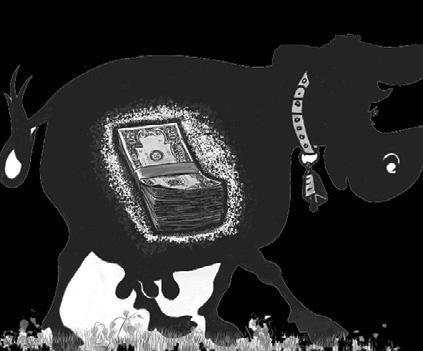


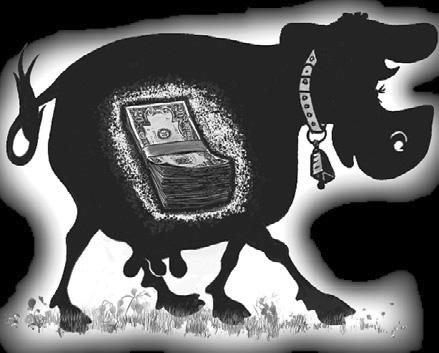







By Stacey Smart stacey.s@dairystar.com
PLYMOUTH, Wis. —
As the holiday season approaches, one veterinary clinic and its clients are giving back to their communities with milk in the spotlight. Through its “Gallons of
Goodness” campaign, Dairy Doctors Veterinary Services has set a goal to donate 3,000 gallons of milk to local food pantries and food banks in a ve-county area. During the one-month campaign, Dairy Doctors is asking its clients and industry supporters to help them reach their goal with a monetary
donation that equates to 10 gallons of milk or more.
“We’ve had a great response with more than 1,500 gallons donated in the rst week,” said Dr. Chris Booth, one of the owners of Dairy Doctors. “This campaign provides a simple way for our clients to share their goodwill with others in the community, and it’s neat how they’ve responded and kicked in donations.”
Dairy Doctors will donate the rst 100 gallons of milk.
For every 10 gallons donated by clients and supporters, the Plymouth-based clinic will donate two additional gallons — up to a total of 400 extra gallons. Dairy Doctors hopes to donate 500 gallons, with clients and other supporters funding the remaining 2,500 gallons to meet their goal.



techniques
stir up and suspend the solids prior to and during the pumping process.
use state-of-the art agitation boats which provide vertical agitation throughout the lagoon. It can easily stir up and maintain the solids in suspension. In addition, Lagoon Pumping uses traditional stick agitators to wash down the banks and to maintain a horizontal movement to the lagoon to assure suspension of the solids throughout the pumping process.


Due to the perishable nature of milk, Dairy Doctors is not donating actual gallons, but rather, the dollar equivalent to match the cost of 3,000 gallons. Contributions will be used by local food pantries and food banks to purchase dairy products for distribution within their communities.
Turn to DAIRY DOCTORS | Page 13
“Our clients are really excited that we organized this and that they have an opportunity to participate,” Booth said. “They’re dairy farmers and appreciate promoting dairy products and getting those products into the hands of families in need.”



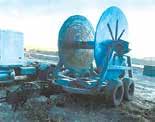

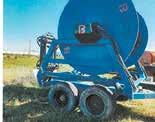
Mary Bender, Dairy Doctors ofce manager, said the goal is to provide as much milk as possible during the holiday season and beyond.
“We want to share the blessing of wholesome dairy products with others in our communities,” Bender said. “Milk is a unique thing to donate, but there is certainly a need. Our hope is the funds provided will extend weeks and months into the future for each organization to purchase milk and other dairy products.”
Booth and his team initiated a pilot campaign in 2018 that surpassed their 1,000-gallon goal by nearly 2,000 gallons. The donations were sent to two food pantries in Sheboygan County.
“It went over really well,” he said. “We haven’t done it the last few years, but our staff expressed interest in wanting to do some type of community service activity, which spurred us into action again this year.”
The campaign has expanded to reach four additional counties: Manitowoc, Calumet, Fond du Lac and Ozaukee. Donors can choose to give their donation to one or more of the recipient organizations in these counties.
“Our practice area expanded, and we wanted clients in those areas to be able to donate to their local food pantry,” Booth said. “Some have donated to multiple pantries. The campaign is very exible in allowing people to choose how to apply their dollars.”
As the clinic supports their community, Booth said their efforts are being greeted with generosity that ex-
tends beyond their clientele.
“Some of our suppliers and pharmaceutical companies and random people from the community who follow us on Facebook have brought in donations,” Booth said. “A local FFA chapter donated 100 gallons.”
Booth said he was pleased with the number of shares the campaign received when it was announced on Facebook.
“It was mostly our clients sharing it with their families and friends, and it was great to see support for it right away,” he said. “Hopefully, this spurs activity for others around the state and country to set up something similar.”
Dairy Doctors is collecting donations until Nov. 30 and will turn the donations over to the beneting organizations in early December. Booth said each pantry handles the acquisition of dairy in different ways.
“We’re letting them utilize the funds to help expand the system they’ve already created,” he said.
During the holidays, the Gallons of Goodness campaign aims to help those less fortunate enjoy the nutritious benets of milk — a staple not easily accessible to everyone Bender said. All donations will make a positive impact, she said, as the need is great and continues year-round.
“We challenge people outside of the areas we serve to nd out what their local food pantry or food bank does to provide dairy products to those in need,” Bender said. “It’s important to understand that the need is everywhere.”

























www.franzensales.com







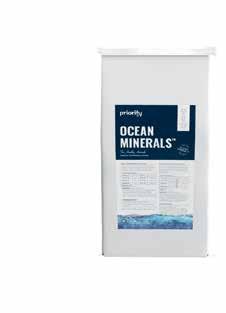






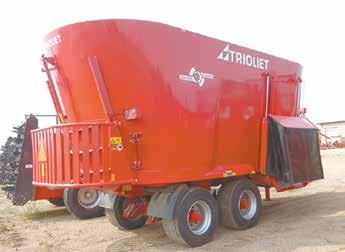


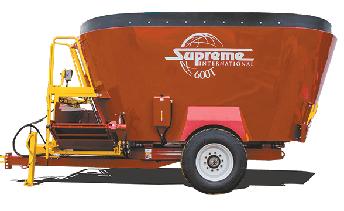







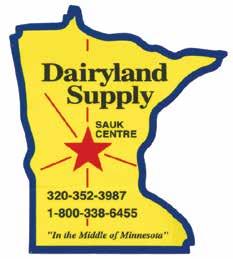














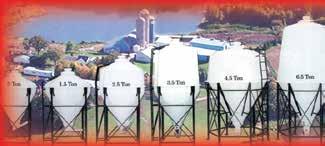








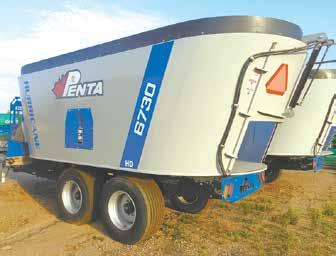
This calendar year, what are you thankful for?
Steve and Candy Turnquist Greenwood, Wisconsin Clark County
75 cows
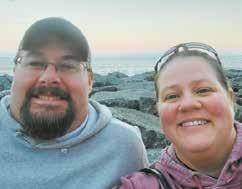
This calendar year, what are you thankful for? We are thankful for the crops we got after the wet spring and early summer we had. We planted most of our corn in mid-May before the rain began. We had to do rst-crop hay May 31 due to our silo being empty. We snuck that in between the rains. Then we nished planting the last 15 acres of corn and 50 acres of soybeans June 10. The hay was great this year. The early planted corn was great — the later and low-end elds of corn, not so much. The soybeans took a hit, too, between the rain, raccoons and deer.
Family aside, what are you most grateful for? We are both grateful for being able to farm together without one of us having an off-farm job. But that could change, as we are unsure what the future will be for small farms. We are grateful that we have the equipment to do the eldwork ourselves now instead of waiting for a combine to harvest our crops. That has been so nice.
On a daily basis, what ways do you show appreciation? We farm and work hard to carry on the tradition, showing our kids what a good work ethic is. We are grateful for the chance to be together every day doing what we love to do.
What is your favorite tradition related to Thanksgiving? Steve, the boys and I hunt deer, so we get up early opening morning to get chores done, crossing our ngers everything goes right so we can get out there before dawn. Thanksgiving Day we always spend the day with family, lling up with all the great food.
What three essentials can you nd on your Thanksgiving plate? Turkey, mashed potatoes and baked corn are what you will nd on our plates.
Tell us about your family and farm. We have about 75 cows and about 50 head of youngstock. We ship to Mullins Cheese. We own 200 acres and rent 140 acres. We grow corn for silage, high-moisture and dry corn; soybeans; wheat or oats depending on the year; and seed down alfalfa/clover/grass mix every year. We have 4 kids — Madison, 14; Sawyer, 13; Trevor, 11 and Casey, 7. They help out a lot with their specic chores, whether it is feeding calves, cleaning pens, feeding cows, milking, driving tractor, etc. We can count on the older ones to help nish if we have a meeting to attend at night. They also have their fair animals of pigs and dairy steers in the spring and summer to feed and work with every day. We always try to get a summer and a winter vacation each year. We are hoping for snow to get some snowmobiling in and sledding and tubing around the farm.
Tom Kauer
Walworth, Wisconsin
Walworth County
600 cows

This calendar year, what are you thankful for? I am most thankful for my health. I had some health problems, but I think I am on top of them now. Good health is what we all should be most thankful for above everything else.
Family aside, what are you most grateful for? I am most grateful for the dairy industry as a whole and the people who are involved in it. We all watch out for one another and are thoughtful of each other, and that’s important.
On a daily basis, what ways do you show appreciation? I show appreciation by being a nice guy and being mindful of the fact that the people I work with are my partners. That is very important in ensuring that our employees and partners understand that we’re all in this thing together.
What is your favorite tradition related to Thanksgiving? Getting together and sharing and being thankful that we are alive and healthy is my favorite tradition. I think Thanksgiving is my favorite holiday. It’s the holiday that has the least amount of pressure, even though we still have to do things related to our jobs. The animals come rst, and it is important that our families know and understand this. Animals do not know it is Thanksgiving and that we are having a feast. It takes a certain kind of person to understand that our families include our animals, and that they must be cared for, even on Thanksgiving.
What three essentials can you nd on your Thanksgiving plate? Turkey, mashed potatoes and squash.
Tell us about your family and farm. I am the third generation at Kauer Farms LLC where I farm with my son, Dan. My son, Brad, dairy farms about 10 miles from here with his family. My daughter, Cathy, is a local realtor, and I also have six grandchildren. Dan is a partner in the business and will be taking over the farm in the future. I have had some health concerns in the last couple of years and am currently injured. I won’t be here forever, and passing the farm onto the next generation is important. I let my son make the calls now, and that’s pretty cool for a father. Every father dreams that his kids will take over. When my grandpa started here, he milked 13 cows, and we kept growing with each generation. We have 14 full-time and part-time employees. Cows are milked three times a day in a double-12 parallel parlor and we ship our milk to Dairy Farmers of America. I’ve always loved this life. There was never a time in my life that I did not totally enjoy what I do, and I am proud of the fact I can say that.


Jeanie Tesch (pictured with daughter, Kelsey) Dorchester, Wisconsin Marathon County 300 cows

This calendar year, what are you thankful for? For many central Wisconsin farmers, this year’s cropping season has been truly interesting because of an extremely wet spring and summer. We are thankful for what crops were harvested and for having a beautiful fall. This spring, unfortunately, we had a barn re due to a lightning strike. We are thankful for our rst responders, good insurance and all the neighbors who helped with the clean-up and showed their support. I am most thankful for my family’s good health and being blessed with a new baby in the spring of 2025.
Family aside, what are you most grateful for? I am very grateful to be the Colby Dairy Breakfast coordinator for the past 10 years. Every year the host farm, supporters, sponsors and attendees get better and better. The support that is shown for the agricultural community lls my heart with pride. Knowing that we are making an impact and teaching about the dairy industry is very gratifying.
On a daily basis, what ways do you show appreciation? Showing appreciation can be done in many ways, using manners and showing appreciation for everyone in your life. A simple please and thank-you goes a long way to people you know, and those you do not, along with writing thank-you letters for acts of kindness and smiling at everyone who enters your life.
What is your favorite tradition related to Thanksgiving? Sitting down with the family and having a good meal; but most importantly, eating as much as you want and never feeling bad because it is a holiday.
What three essentials can you nd on your Thanksgiving plate? I enjoy turkey, stufng and my favorite, crumb pie.
Tell us about your family and farm. My husband and I farm with his parents. We are very lucky to have his siblings and spouses who can help with a wide variety of things, from lling in for milking chores to driving tractor to helping us with our children's many activities. We have a double-16 parallel parlor setup. We ship our milk to Lynn Dairy & Lynn Proteins Inc. We farm 850 acres, owned and rented, on which we grow corn, hay and winter wheat as cow feed.

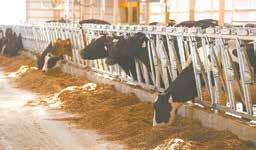
Chad Sime
Gays Mills, Wisconsin
Crawford County 130 cows
This calendar year, what are you thankful for? This year I’m extremely thankful for a more normal growing season, after last year’s drought. A healthy family is something I’m always thankful for.
Family aside, what are you most grateful for? I’m extremely grateful that I get to get up and farm every day. I denitely like it some days more than others, but a southwestern Wisconsin dairy farm is denitely a great place to be. Having excellent hired help and an entire family that pitches in daily with the workload is truly a blessing.
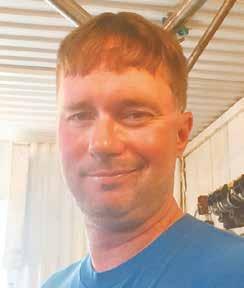
On a daily basis, what ways do you show appreciation? We are a Christian family and thank God every day for what we have been able to obtain through hard work and dedication. My wife, Sarah, and I try to give back to the community we live in by serving on various church, agriculture and school boards, and organizations.
What is your favorite tradition related to Thanksgiving? Chores, deer hunting, watching the Macy's Thanksgiving Day Parade, watching football and a couple big meals. We eat at both my and my wife’s family’s on Thanksgiving. This is usually how most of our Thanksgiving Days are spent. And it is thoroughly enjoyed by all. What three essentials can you nd on your Thanksgiving plate? I’m a big tradition guy, but I denitely prefer ham over turkey for my Thanksgiving meal meat, some green bean casserole and a slice of homemade pie will denitely nd their way onto my Thanksgiving meal plate.
Tell us about your family and farm. My family consists of my wife, Sarah, son, Carson, daughters, Rita, Johanna, Mary and Joy, and me. In addition to helping with chores, Sarah works as bookkeeper for the Seneca Area School District. All the kids pitch in for chores and Carson grabs the bull by the horns with any job on the farm when he’s not at school or football. He plans to return here after continuing his education post-high school.
Noah Allan is our only full-time employee outside the family and does an excellent job. I couldn’t ask for anyone more trustworthy and dedicated. My dad, Alan, works for the local township and is the farm mechanic. He helps wherever needed when not at his day job.
We ship our milk to Scenic Central Milk Producers and have been extremely happy with our 10 plus years with them. We house our herd of Holsteins, Brown Swiss and Jerseys on pasture, weather permitting, and in sand-bedded free stalls. The cows are milked in a double-13 parlor that was retrotted into our existing dairy barn three years ago this coming January. We own 240 acres (110 tillable) and rent another 180 crop acres and about 90 acres of pasture. We grow corn, alfalfa and oats for forage. Part of the cropland is certied organic and we market about 25 acres of corn annually through Organic Valley's grower pool.
Travis and Kayla Hach
Do Dandy Dairy Ontario, Wisconsin Vernon County 6 cows
This calendar year, what are you thankful for? We are thankful for the opportunity God gave us in 2024 to attempt to purchase a dairy farm from an older dairy-farming couple. We threw ourselves wholeheartedly into learning about someone’s operation, grass milk dairy farming and living our dream. We are deeply grateful for the way we were allowed to join in on the dairy and work to bring our dream of running our own dairy farm to life, even for a short time. Unfortunately, four months into the endeavor, the owners decided not to sell.

Family aside, what are you most grateful for? We are grateful for the North American Normande Association. NANA was established in 1974 to promote the Normande breed in both the dairy and beef industries, create a breed registry, ensure the integrity of U.S. Normande genetics, and collect data to improve breeding programs. In 2017, Travis fell in love with the Normande dairy breed at a farm he worked on, and we purchased our rst Normande cow. We went on to purchase a heifer calf that taught us about the beef versus dairy lines of the Normande breed. She was advertised to have dairy genetics, but was clearly beef once she was grown. Today we have two registered Normande cows and expect three Normande calves in 2025 — hopefully heifers. We are members of NANA, and Travis hopes to serve on the board of directors. In addition, we received the honor of grand champion dairy cow at the National Normande Show in 2023 and 2024 with our registered cow, Do Dandy Jasmine.
On a daily basis, what ways do you show appreciation? On a daily basis, we show appreciation in small ways to one another and our family. We understand that appreciation is not always a grand gesture, but the consistency of actions and behaviors to serve one another and God each day. This is done by telling each other, “I love you,” every time we hang up the phone and making sure our children know they are loved and supported by their family.
What is your favorite tradition related to Thanksgiving? Thanksgiving for the Hachs is full of family, farming, good food and hunting. Travis is an avid bow hunter and teaches the skill to his children. He is also working on engaging his wife in this sport so that we can have a family hobby. He is passionate about providing food for his family through bow hunting. Kayla enjoys working with the children on their rabbit project of raising meat rabbits to provide food for the family. Either way, we stay busy and enjoy creating memories along these avenues outside of fair and dairy show season.
What three essentials can you nd on your Thanksgiving plate? Stufng, mashed potatoes and ham or rabbit, preferably not dry turkey.
Tell us about your family and farm. We were married in 2017 and recently celebrated our seventh wedding anniversary. We have three children: Nara, 11, Samuel, 10, and Harvey, 4. Over the past two and a half years, we have attempted to start our own farm three times, unsuccessfully. At this point, we have accepted that having our own farm is not in the cards for us and help on Kayla’s parents’ farm, Harvey and Jackie Menn’s Lawn View Farm, in Norwalk. Kayla is the sixth generation to have grown up on this farm. Our cattle are housed and milked here. Since this farm has had six generations of no other dairy breed but Jerseys, we are grateful that Kayla’s parents allowed us to mix it up and develop the Normandes we love on their farm. Cows are milked in a double-4 parlor and housed in a freestall barn. They farm 330 acres, 250 tillable, 60 pasture. The farm has been certied organic since 2009 and ships milk to Westby Cooperative Creamery.



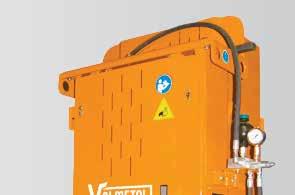















How many times a day do you milk, and what is your current herd average, butterfat and protein? We milk twice a day and our current herd average is 26,329 pounds milk, 1,132 pounds fat (4.4%) and 887 pounds protein (3.4%).
Describe your housing and milking facility. Our cows are housed in a freestall barn that was built in 1972. We added on to the building around 20 years ago. Most of the stalls, 57, have waterbeds; the rest are bedded with sand. We milk our cows in a double-4 herringbone parlor. We also have a sprinkler system that kicks in when the temperature is 68-70 degrees. We don’t see a decline in milk production when it gets hot.
Who is part of your farm team, and what are their roles? I, Kevin, am the herdsman on the farm and Pete is in charge of the crops and machinery. We have one full-time person along with three parttime helpers. They take care of most of the milkings.
What is your herd health program? We do a herd check monthly and the cows get vac-

Kevin (le ) and Pete Ackerman stand near their close-up pen Nov. 13
Rapids, Minnesota. The Ackermans milk 118 cows and
fat, and 887 protein.
cinated twice a year with Triangle 10. The calves get Nasalgen 3-PMH at birth and four
weeks later. The older heifers get Bovi-Shield 10-way.
What does your dry cow and transition program consist of? The cows are dried off at
60 days and moved to a calving pen three weeks before calving. Their ration consists of corn silage, grass hay and minerals. They receive a pre-fresh protein mix in the calving pen. They are housed in a 3-sided shed that is bedded with corn stalks.
What is the composition of your ration, and how has that changed in recent years? Our ration consists of alfalfa haylage, corn silage, highmoisture corn, dry hay and a protein mix. We really haven’t changed much in the last several years.
Tell us about the forages you plant and detail your harvest strategies. We raise alfalfa and corn silage and try to harvest them at the highest quality. We usually harvest our alfalfa at the bud stage and try for four crops. The intervals are usually 28-33 days. We shoot for 65% moisture on our corn silage. Our forages are stored in bags or silos. We ll four 10-by-200 bags and two stave silos. One is 20-by-60 and the other is 18by-55.







































































































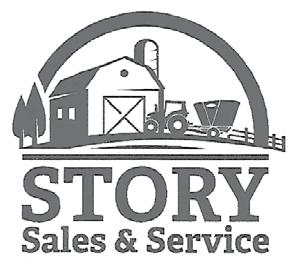















































































“If you don’t have cow comfort, nothing else seems to matter. We minimize stresses at calving on her feet and legs, making sure she has feed and water and a good place to rest, she’s clean and she’s dry.
“That leaves the udder as the next thing to take care of, and with Udder ComfortTM they transition a lot more smoothly,”
Maynard, Iowa, milking 750 95 pounds of 4.2 fat milk.
“For 10 years we used Udder Comfort periodically. At the 2022 World Dairy Expo, they talked me into trying the Udder Comfort Battery-Operated Backpack Sprayer. I didn’t think it insisted, and they were right!
SCC fell from 165 to 137,000.
“We also notice any clinicals that do show up, clear faster, and don’t
“Now, we continue to use it 3x/day on all fresh cows for a week after calving. If we have a mastitis cow or high SCC, or anything not perfectly normal, we spray it on
“With fresh cows, we see a lot more udder texture at 2 weeks in milk as edema is pulled out. You can They’re up moving around more. They eat. They drink. They make more milk and higher quality milk.
“The Udder Comfort Backpack Sprayer made us more compliant on our udder health. It’s more user-friendly












































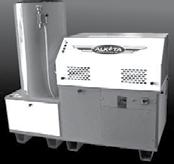




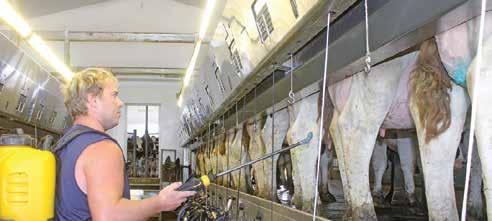
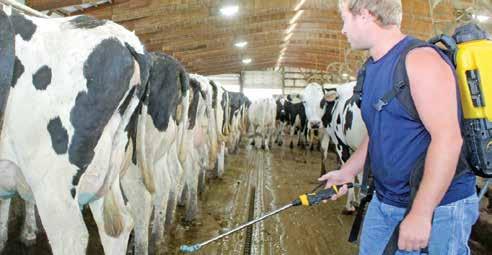

























MARK KLAPHAKE/DAIRY
Kevin Ackerman stands near big square bales of alfalfa Nov. 13 on the farm he operates with his brother, Pete, near Sauk Rapids, Minnesota. The Ackermans focus on pu ng up high quality feed on their third genera on farm.
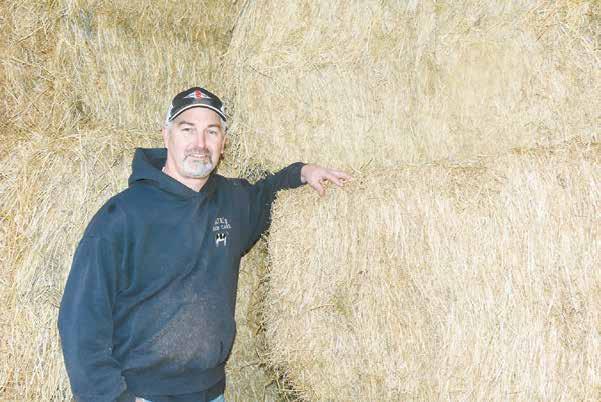
What is your average somatic cell count and how does that affect your production? Our somatic cell count is 91,000. We have been in the top 100 for SCC in Minnesota for several years.
What change has created the biggest improvement in your herd average? Genetics. I do some embryo work on the better animals. We are not afraid to spend money on good bulls. I focus on production, components, good feet and legs and udders, 1.5 or better. I usually select higher genomic sires.
What technology do you use to monitor your herd? We test through Minnesota Dairy Herd Improvement Association and we are 95% registered through Holstein Association USA. We genomic test all our heifers in the rst three months.
What is your breeding program, and what role does genetics play in your production level? All our females are on a mating program from Select Sires. Genetics are very important to us. We spend the money on better bulls. My ag instructor once told me you only get 20 crops of females if you milk for 40 years.
List three management strategies that have helped you attain your production and component level. Genetics, making high-quality feed and putting a rubber mat over the slatted oors in the free-stall barn, which has added more comfort for the cows.
Tell us about your farm and your plans for the dairy in the next year. We are a third-generation farm that was started in 1944 by our grandpa, Bart. My dad, Adrian, took over in 1965 and Pete and I took over the farm in 1994. We farm 500 acres.















• Hoof Health Products
• Boluses














• Pharmaceuticals
• Injectables
balling guns, magnets and many other animal health items.
• Intramammary Infusions
• Dewormers
• Scours, Diarrhea Products
• Nutritional Products





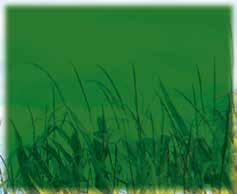
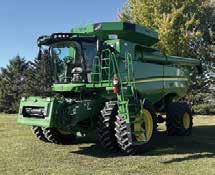


















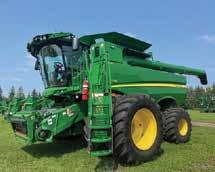









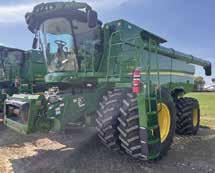



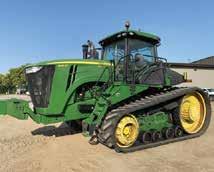












Contact one of the following dealers to learn more:
IOWA
Prairie Land Ag Supply Inc.
Rock Valley, IA 712-476-9290
United Dairy Systems, Inc.
West Union, IA 563-422-5355 Monticello, IA 319-465-5931
WISCONSIN
Advanced Dairy Spring Valley, WI 715-772-3201
Bob’s Dairy Supply Dorchester, WI
715-654-5252
Ederer Dairy Supply Plain, WI
608-546-3713
DeLaval Dairy Service Kaukauna, WI 866-335-2825
Joe’s Refrigeration Inc. Withee, WI 715-229-2321
Professional Dairy Services Arlington, WI 608-635-0268
Redeker Dairy Equipment Brandon, WI 920-346-5579
The Scharine Group Inc. Whitewater, WI 800 472-2880 Mt Horeb, WI 800-872-3470
MINNESOTA & SOUTH
DAKOTA
Farm Systems
Melrose, MN
320-256-3276
Brookings, SD 800-636-5581
Advanced Dairy Mora, MN
320-679-1029 Pierz, MN
320-468-2494
St. Charles, MN
507-932-4288
Wadena, MN
218-632-5416










There is a fairy tale that comes to life in Louisville, Kentucky, the rst Sunday of November each year. The lights over Freedom Hall dim, and then, that year’s class of the National Jersey Jug Futurity steps onto the green shavings, each cow spotlighted as her name is announced.
The National Jersey Jug Futurity, held with the All American Jersey Show, is the oldest and richest continuous dairy cattle class in the world, and the pageantry and prestige of Jug Day live up to its history. The class is lled with suspense. After the dramatic entry, the rst pull of cows is made in numerical order, and cows stay in numerical order until each is placed. Eventually, the six top cows remain. Their placings are announced over the microphone until two remain. The winner is draped with a purple banner by the judges and a collar of roses is placed around her neck.
Jug and was in awe of the tradition.
Our Jug dreams began in 2009 when Austin purchased Tierneys Barbaro Lucine, a heifer entered in the Jug. In 2010, Austin and my dad spent the trip back home from Louisville making plans for taking Lucine back for her Jug appearance the next year.
My dad did not make it to the 2011 Jug as he passed away Dec. 26, 2010. Lucine did not make it to her Jug Day either as she did not settle in time to calve and be ready.

By Danielle Nauman Staff Writer
Making it to the spotlight on Jug Day is no easy feat. Calves are entered, and nomination fees must be paid by various deadlines. Heifers need to calve in with the exceptional quality of udder that can potentially propel them to the top. Cows need to breed back, ensuring they are at their prime come November. So many things can keep a cow from making it to the Jug.
Growing up a Holstein girl, my dad was passionate about the art of breeding and I was raised with the understanding that a good cow, was a good cow, regardless of her color. My dad was always intrigued by the mystique surrounding the Jug, and he admired those who could capture that moment.
I watched my rst Jug on my rst trip to Louisville in 1994, just a few months after purchasing my rst Jersey. The desire to breed a Jug winner began to sprout within me.
When my son, Austin, made his rst trip to the All American in 2008, he saw his rst
In 2015, we came close. Lucine’s daughter, Smokin Hot Rendition Letitia, nished fth. The exhilaration of watching her parade among the nal six is a feeling I will never forget.
This year’s Jug dreams began July 16, 2021, when Smokin Hot Texas Tornado was born. A young milking yearling calved with a heifer calf sired by Guimo Joel-ET, nearly a week overdue. We were excited about the yearling’s future, but it was her calf that caught my attention.
Some calves are born special, and Texas Tornado was one of them. I swear she may have actually told me she was as her mother licked her off. Thoughts of roses and November Sundays ickered through my head.
We consign many of our calves to sales. When the sale managers came looking for consignments that winter, TT was passed on because of her birth date. That was ne with me, I was committed for the long haul.
The next year as the sale managers came looking, Michael Heath took an interest in the chubby, young, bred heifer, about 60 days from her due date. He told me to be sure to have Austin let him know when she calved in good.
Just a few days before the farm accident that ultimately took his life in mid-March, Michael inquired about the “good young Joel.” TT went a week over, calving the morn-


ing of March 22, 2023, just a couple of hours before I got word that Michael’s family had decided to take him off life support.
TT calved with a lovely little udder, and every day brought improvement, growth and change. We showed her successfully as a twoyear-old, got her bred back and put our focus on Nov. 10, 2024 — the day of the National Jersey Jug Futurity.
Just a few days before TT calved, the bird u struck America’s dairy industry, and concerns about the movement of livestock being restricted began to cloud my thoughts. We kept TT home throughout the year for fear of potential quarantines in the event of exposure to a positive cow, keeping our focus on the Jug.
Early the morning of Nov. 4, I put TT on a trailer, headed for her date with destiny in Louisville. I stayed home, with plans to watch the live feed from Freedom Hall.
Anxiously I watched, perched on the




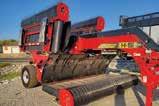

edge of a ve-gallon bucket directly in front of the television. I watched as TT made the rst pull, as she was sent to the group of 11, and as that narrowed down to the group of six. The sixth-place cow was announced...fth... fourth...third.
My heart raced. Two cows were left standing.
I felt a quick icker of disappointment when the purple banner did not waft down over her shoulders. But this was followed with awe. Texas Tornado had nearly accomplished the unimaginable as she was named the Reserve Winner of the National Jersey Jug Futurity.
The kaleidoscopic emotions running through my mind were intense — were we victorious, or did we fall short? Depending on the moment, I am still not certain of the answer. And then I walk out to the calf hutches and start dreaming of roses on a Sunday in November, three years away, all over again.
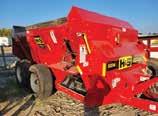
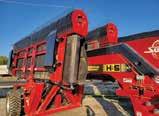
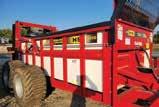












Grand Prize Drawing Will Be Held Wednesday, December 11, 2024
THE WINNERS WILL BE POSTED ON WWW.DAIRYSTAR.COM, MILK BREAK NEWSLETTER AND ON FACEBOOK.
ADULT “GRAND” PRIZE 17 & UNDER “GRAND” PRIZE
2) $500 CASH GIFTS! 2) HEIFER CALVES !

GrandPrize fromCalfcomesAlbedarned Baldwin,Dairy,LLCin Wis.
Look for the red box at participating locations to enter!
PLUS: 11 DAYS OF GIVEAWAYS FOR ADULTS LEADING UP TO GRAND PRIZE DRAWING S
“Grand” Prize Heifer Calf: MS ALBEDARN ADMIRE BELLA
Born: September 12, 2024
Sire: Mystique Admire Dam: GP83 Brenland Domino daughter
will be given away in the Great Christmas Giveaway drawing.
REGISTER FREE AT ANY OF THE PARTICIPATING BUSINESSES FOR YOUR CHANCE TO WIN!

BARRON COUNTY
• Equity Livestock, Barron Barron • 715-537-5618
BROWN COUNTY
• Cornette Farm Supply Greenleaf • 920-864-7891
CALUMET COUNTY
• D&D Equipment Chilton • 920-849-9304
• Gruett’s Potter • 920-853-3516
• Stanley Schmitz Chilton • 920-849-4209
CHIPPEWA COUNTY
• Chippewa Farm Service, LLC
Chippewa Falls • 715-382-5400
• Chippewa Valley Dairy Supply
Stanley • 715-644-2350
CLARK COUNTY
• Cherokee Garage Colby • 715-223-2374
• Cloverdale Equipment Curtiss • 715-223-3361
• Northern Lakes Vet Supply Abbotsford • 715-223-4700
• Silver Star Metals Withee • 715-229-4879
COLUMBIA COUNTY
• Equity Livestock, Arlington Arlington • 608-635-4376
DODGE COUNTY
• Central Ag Supply Juneau • 920-386-2611
• Equity Livestock, Lomira Lomira • 920-269-7150
• Knowles Produce & Trading Lomira • 920-583-3747
• Schraufnagel Implement Lomira • 920-269-4307
• Waupun Equipment Waupun • 920-324-3597 Watertown • 920-261-5301
DUNN COUNTY
• Leedstone Menomonie • 866-467-4717
• MAC Contractors Menomonie • 715-232-8228
• Midwest Livestock Systems Menomonie • 715-235-5144
EAU CLAIRE COUNTY
• Equity Livestock, Altoona Eau Claire • 715-835-3104
FOND DU LAC
• Eden Equipment Eden • 920-477-5292
• Redeker Dairy Brandon • 920-346-5576
GRANT COUNTY
• Dickeyville Feed Dickeyville • 608-568-7982
GREEN COUNTY
• Equity Livestock, Monroe Monroe • 608-328-8344
• Lely Center Monroe Monroe • 888-927-4450
• Monroe WestfaliaSurge/Koehn, Inc. Monroe • 608-325-2772
• Top Notch Feed & Pet Supply
New Glarus • 608-527-3333
JACKSON COUNTY
• W.H. Lien, Inc.
Hixton • 715-963-4211
JEFFERSON COUNTY
• Equity Livestock, Johnson Creek Johnson Creek • 920-699-3588
LAFAYETTE COUNTY
• Center Hill Veterinary Clinic Darlington • 608-776-4083
• Darlington Feed LLC Darlington • 608-776-3862
• J Gile
Cuba City • 608-744-2661
• Scott Implement Platteville • 608-348-6565
MANITOWOC COUNTY
• Equity Livestock, Reedsville Reedsville • 920-754-4361
• Miller Implement St. Nazianz • 920-773-2800
MARATHON COUNTY
• Brubacker Ag Equipment, LLC Edgar • 715-613-7308
• Equity Coop Stratford Stratford • 715-687-4101
MONROE COUNTY
• Equity Livestock, Sparta Sparta • 608-269-3104
• Leedstone Sparta • 608-269-3830
OCONTO COUNTY
• Beaver Machine Coleman • 920-897-4035
OUTAGAMIE COUNTY
• Midwest Livestock Systems, LLC Kaukauna • 920-759-9223
PEPIN COUNTY
• Anibas Silo & Repair Arkansaw • 715-285-5317
PIERCE COUNTY
• Ag Partners Ellsworth • 715-273-5066
RICHLAND COUNTY
• Equity Livestock, Richland Center Richland Center • 608-647-6151
ROCK COUNTY
• Complete Feed Sharon • 262-736-3333
• Tri-County Dairy Supply Janesville • 608-757-2697
SAUK COUNTY
• Central Ag Supply Baraboo • 608-356-8384
SHAWNO COUNTY
• Equity Livestock, Bonduel Bonduel • 715-758-2125
• P&D Sales & Service Pulaski • 715-758-2585
• Pulaski Warehouse Pulaski • 920-822-3536
TREMPEALEAU COUNTY
• Centerville Coop Trempealeau • 608-539-3311
VERNON COUNTY
• Koon Kreek Feeds Coon Valley • 608-452-3838
ALLAMAKEECOUNTY
• Equity Livestock, Waukon Waukon • 563-568-4501
• Farmers Union Coop Postville • 563-864-7234
DUBUQUE COUNTY
• Eastern Iowa Dairy Epworth • 563-876-3087
• New Vienna Ag Automation New Vienna • 563-921-2896
• Rexco Equipment Farley • 563-744-3393
• Roeder Implement Dubuque • 563-557-1184
• Scherrmann’s Implement Dyersville • 563-875-2426
• Skip Breitbach Feeds Sherrill • 563-552-2393
• Ungs Shopping Center (IAS) Luxemburg • 563-853-2455
CLAYTON COUNTY
• Windridge Implement Elkader • 563-245-2636
HOWARD COUNTY
• Farmers Win Co-op Cresco West • 563-547-3660
• Windridge Implement Cresco • 563-547-3688
WINNESHIEK COUNTY
• Brynsaas Sales & Service Decorah • 563-382-4484
• Farmers Union Coop Fort Atkinson • 563-534-7216 Ossian • 563-532-9381
• Farmers Win Coop Ridgeway • 563-737-2244
• Franzen Sales & Service Fort Atkinson • 563-534-2724
• Lang’s Dairy Service Decorah • 563-382-8722
• Windridge Implement Decorah • 563-382-3614
DAKOTA COUNTY
• Werner Implement Vermillion • 651-437-4435
GOODHUE COUNTY
• Ag Partners Cannon Falls • 507-263-4651 Goodhue • 651-923-4496 Pine Island • 507-356-8313
• Central Livestock Zumbrota • 507-732-7305
• Finnesgard Trucking Goodhue • 651-923-4861
• Midwest Livestock Systems, LLC Zumbrota • 507-732-4673
• Midwest Machinery Cannon Falls • 507-263-4238 Wanamingo • 507-824-2256
• Stockman’s Supply Zumbrota • 507-732-7860
• Zumbrota Stockman’s Supply Zumbrota • 507-732-7860
HOUSTON COUNTY
• Farmers Win Co-op Caledonia • 507-725-3306 Houston • 507-896-3147
• Hammell Equipment Eitzen • 507-495-3326
• Midwest Machinery Caledonia • 507-725-7000
WABASHA COUNTY
• Ag Partners Plainview • 507-534-2531 Lake City • 651-345-3328
• Beck Implement Elgin • 507-876-2122
• Leedstone Plainview • 800-548-2540
• Midwest Machinery Plainview • 507-534-3116
• Wingert Sales & Service Plainview • 507-534-2285
WINONA COUNTY
• Ag Partners Lewiston • 507-523-2188
• Elba Co-op Creamery Elba • 507-796-6571
• Kalmes Implement Altura • 507-796-6741
• Lang’s Dairy Equipment Lewiston • 507-452-5532
• Lewiston Sales Lewiston • 507-523-2112
• Midwest Machinery
St. Charles • 507-932-4030
• Minnwest Bank Lewiston • 507-523-2161

By Danielle Nauman danielle.n@dairystar.com
LOUISVILLE, Ky. — Some dreams take years, even decades, to realize. For Logan Cliffe, dreams that began as a young Guernsey breeder in Delaware, were nally realized on the green shavings of Freedom Hall at the Kentucky Exposition Center in Louisville.
“They tell you good things come to those who wait,” Cliffe said. “Boy, was this one worth the wait.”
On Nov. 9, her secondgeneration, homebred Guernsey aged cow, Pare-View Pandoras Box, was named the senior and grand champion cow by judge Chris Lang at the National Guernsey Show held during the North American International Livestock Exposition.
Cliffe and her husband, Jack, are lifelong devotees of chasing ribbons and banners at dairy shows throughout the country. Logan works as the parts department manager for Ederer’s Professional Dairy Service while Jack works as a dairy cattle tter. The couple resides in Loganville, Wisconsin.
“It’s an incredible feeling to have success with something you’ve bred and raised — to see her accomplish so much and nally have her time to shine and show everyone that cow she is,” Cliffe said.
The story of how Pandoras Box fullled Cliffe’s dreams dates to 2008 when Cliffe was 14 years old.
Cliffe purchased a bred heifer, Millborne Challenge Pixel, at the Pennsylvania Guernsey Breeders Association’s Blue Halter Sale. Pixel gave Cliffe a taste of showring success and laid the foundation for a calf born nearly 10 years later.
The calf Pixel was carrying — Millborne Fame Pixels Pixie — was responsible for shaping much of Cliffe’s future — igniting Cliffe’s passion for the show ring and introducing her to her future husband.
“I tied Pixie in with Knapp Guernseys at Louisville in 2013,” Cliffe said. “Jack was helping them. That’s when we rst met.”
Pixie’s daughter, PareView Jud Pixie Pumpkin, was a successful show heifer for Cliffe and is the dam of Pan-
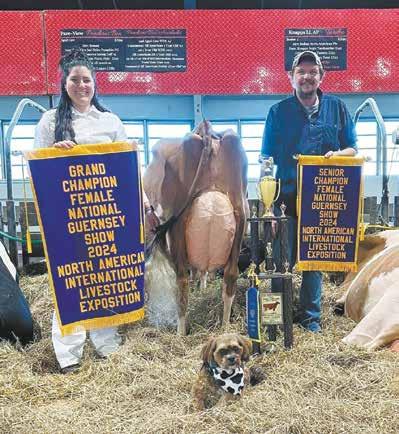
Logan (le�) and Jack Cliffe display the banners won by their Guernsey, Pare-View Pandoras Box, Nov. 9 at the North American Interna�onal Livestock Exhibi�on in Louisville, Kentucky. Pandoras Box, the winning aged cow, was named senior and grand champion of the Na�onal Guernsey Show.
doras Box.
Cliffe said the name Pandoras Box has its own story. “Jack wanted something unique,” she said. “He thought she was going to be something — that she needed to have a name that had a ring to it when it was announced.”
Pandoras Box has built a respectable resume. After solid performances as a heifer, Pandoras Box calved in to prove Jack’s theory. A 2-year-old in 2020, her rst show campaign as a cow was limited to the Wisconsin State Guernsey Show, where she
placed second. She received her rst All-American nomination in milking form.
The next year, Pandoras Box returned to the Wisconsin State Guernsey Show a month fresh. This time she would win the senior 3-yearold class on her way to capturing the intermediate championship banner and being named the honorable mention grand champion.
That October brought a class win at World Dairy Expo, leading to Pandoras Box to being named the AllAmerican Senior 3-Year-Old for 2021.
Following Expo, Pandoras Box suffered her rst setback, aborting a pregnancy. Her 4-year-old show campaign was limited to an appearance at the Midwest Quality Colors Spring Show, where she won her class and was named the senior and honorable mention grand champion.
As a 5-year-old, Pandoras Box hit the colored shavings of World Dairy Expo winning the class and being pulled out for champion alongside Guernseys like Malt, Uno and Lovely. She was selected as the unanimous All-American 5-Year-Old in 2023.

















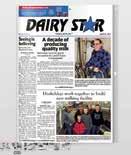


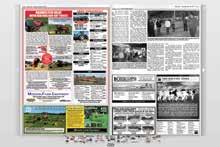




e hugs
as
the
of grand
the North American Interna�onal Livestock Exposi�on in Louisville, Kentucky. Pandoras Box descends from a heifer Cliffe purchased in 2008 when she was 14 years old.
“She’s always been right there for a banner, always so close,” Cliffe said. “She’s always been behind cows that are good, that have made a name for themselves. That is something I don’t think a lot of cows can say, that they’ve always been right there with cows that have been winning.”
Pandoras Box spent her rst three lactations residing at KnH-Endres near Loganville, Wisconsin, under the care of Kevin, Heidi and Tyler Endres. As she grew older, the Cliffes moved her to Rosedale Genetics Ltd near Oxford, Wisconsin.
During her fourth lactation Pandoras Box met another speed bump — she suffered a displaced abomasum about 40 days before she was set to head to WDE.
“She stood second to Uno at Expo, which we were very happy about,” Cliffe said. “But we knew she wasn’t at her full potential. She was still ghting through everything, still coming around.”
The Cliffes decided that with another month’s recovery, Pandoras Box deserved a trip to NAILE.
“She came off the trailer in Louisville, started eating and never stopped,” Cliffe said. “She knew she had something to do, that it was her last shot to prove something this year.”
A show ring veteran, Cliffe said nothing could have prepared her for the tide of emotions that enveloped her on the green shavings.
The enormity of what the cow had accomplished and the obstacles she had overcome on the way to making a dream come true overwhelmed her, Cliffe said.
“When Chris (Lang) came towards me for the high ve for senior champion — it’s a feeling like no other, you can’t describe it,” Cliffe said. “Then when he came towards me for grand, I lost it. They never tell you that when it’s your own cow you’re just going to cry like a baby.”
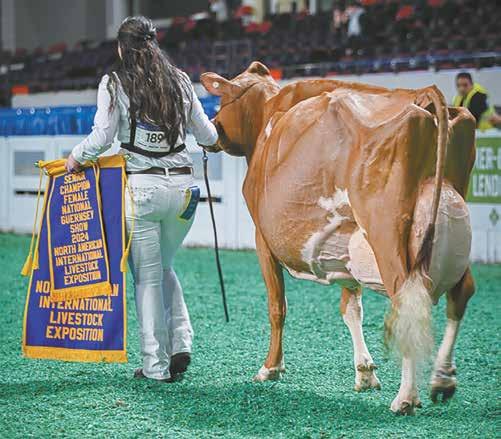





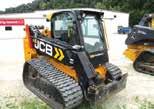

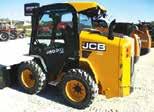














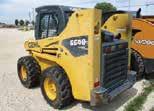






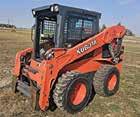
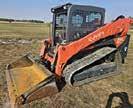



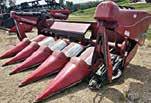
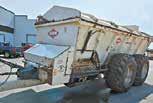


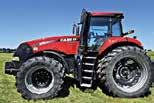

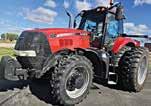


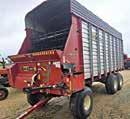


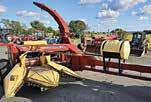





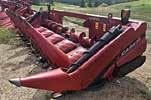
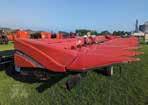
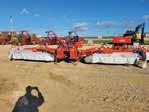
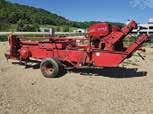
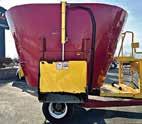

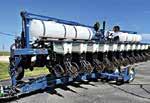

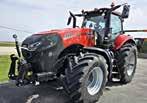







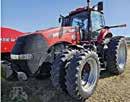



By Dan Wacker dan.w@dairystar.com
SPARTA, Wis. — At the beginning of November, for the rst time since it opened in 1979, the sign identifying Preston’s Dairy Equipment in Sparta now reads Leedstone. Dan and Jill Preston are heading into retirement, and with that, Preston is relinquishing control of the company his family established in Union Center in 1947.
With the transition, Leedstone will continue to provide the same products and services with the same team of employees.
Preston’s Dairy Equipment sold dairy equipment and services for the past 77 years, including installing milking systems, cattle waterers, ventilation and cattle stalls.
Preston worked at his father’s shop in Union Center on the installation side of the business after graduating high school. After a few months, his father, brother and brother-in-law told him they were buying another location in Sparta. At 21 years old, Preston and Jill moved to Sparta. He worked at the new dairy equipment store and she worked in the Production Credit Association ofce.
“Our company man wanted us to move up here,” Preston said. “Jill and I both thought we should go, so we jumped at the chance. She was working for PCA, and their headquarters were in Sparta, so it was an easy move for her.”
With the move, Preston went from installer to businessman nearly overnight.
“I had done nothing but install at that point,” Preston said. “The sales and the rest of the business aspect were pretty crazy to me. I had never even written out a check before and now I was writing payroll checks to our two employees. It was learning on the y for sure.”
After opening the second location,

Preston got to work. The company was servicing over 1,100 farms in the area.
“We would buy 50 pipelines at a time, 25 would come here to Sparta, the other 25 would go to Union Center and we did that probably two or three times a year,” Preston said.
With the installation of so many pipelines and bulk tanks, the service end of the business grew and became a focus. Customer service was a priority, Preston said and customers felt that level of importance.
“When someone calls for service, we have to cover that call today,” Preston said. “If I had a sales call or a service call, the service call always came rst.”
That reputation helped them expand their coverage area from farms in Monroe County to seven counties in Wisconsin and three in Minnesota.
Preston has seen the passing of the torch in the dairy industry, with some of his customers being in their third generation.
“They still come here and work


of town and has since been engulfed by urban sprawl.
After serving the dairy industry for 46 years, Preston has seen developments in dairy technology and cow care.
“We’re setting up ventilated barns and sprinkler systems now,” Preston said. “People are taking care of cows way better than they used to and the numbers show that.”
Over the past decade, milk production per cow has grown by 8.4% annually on average in the U.S. according to the U.S. Department of Agriculture National Agricultural Statistics Service.
“Twenty years ago, if we had people getting 60-70 pounds a cow, you were doing well,” Preston said. “Now, we have full herds of over 800900 cows that are averaging over 100 pounds a cow.”
Though there is new ownership, the location will continue to offer services it has had in the past.
with us and have a lot of respect for the whole crew,” Preston said. “Seeing that loyalty, and our great employees has been rewarding. When we have new employees come in, they’ll stay here for 15-20 years, and that’s pretty cool.”
When Preston’s Dairy Equipment was established in Sparta, it was initially located downtown before moving to its current location. It was one of the rst businesses to build on the west side
“We’ll be the only Leedstone location that will work on the waterers, xing motors, ventilation and barn equipment,” Preston said. “That’s what we’ve done in the past and they trust us to continue to provide those services to this area.”
The full transition to Leedstone will take about a year. Preston is staying on for the next 12 months, working with small sales, minor excavating projects, educating the new company on the lay of the land and providing the service his customers have grown accustomed to.
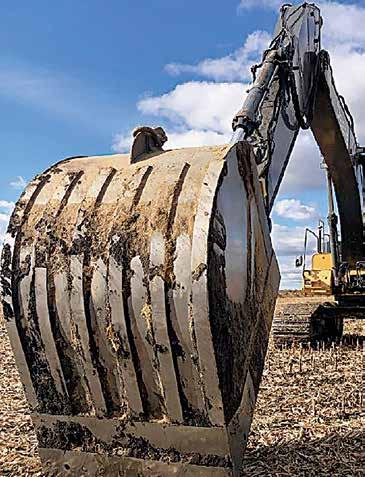

















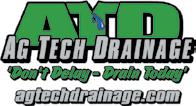




Last month during World Dairy Expo, I attended the Council on Dairy Cattle Breeding industry meeting to learn about what was new on the horizon for dairy cattle genetic evaluations in the United States. Dr. John Cole provided updates from CDCB and Dr. Asha Miles provided updates from the U.S. Department of Agriculture Animal Genomics and Improvement Laboratory. These two groups work closely together to research traits that may eventually become part of national genetic evaluations. Some of the topics discussed included lameness, milking speed and calf health traits.
Lameness and milking speed

ed camera data that assigns mobility (lameness proxy) scores and hoof trimmer data. Heritability estimates have ranged from 0.05-0.27, suggesting there is opportunity to genetically select for animals with reduced lameness and hoof lesions. In the future, the group is looking to explore the use of producer and trimmer lesion data that producers record in herd management software.
By Isaac Haagen University of Minnesota
Dr. Cole presented updates on lameness and hoof health, which are active areas of research for CDCB. The CDCB has been working with researchers at the University of Minnesota for several years to develop genetic evaluations for lameness and hoof health. There is a lot of interest in lameness, as it is often noted as one of the most pressing welfare concerns for the dairy industry and has negative economic consequences. So far, the data for these evaluations has come from automat-
Dr. Miles reported on the status of milking speed genetic evaluations. The trait exhibits a moderate genetic correlation with somatic cell score at 0.37 and a small genetic correlation with Net Merit at 0.10. She noted that one of the biggest hurdles right now is the ow of data from farms to the National Cooperator Database, which is the national repository of genetic and phenotypic data.
Calf traits
In addition, there is ongoing work to bring calf disease traits to national evaluations. Dr. Miles reported on preliminary research from the USDA AIGL in Holsteins and Jerseys. There were about 200,000 observations available for diarrhea and just under 700,000 observations for respiratory disease.
Early results are promising, with heritability estimates for both breeds at 0.02-0.03. While small, these heritability estimates are great enough to utilize for genetic evaluations.
One of the interesting points from the discussion was that there is less calf data owing into the National Cooperator Database after 2021. This is important because more records will improve evaluations and continued up-to-date information is needed to ensure evaluations stay relevant. This also highlights the need for data to be routinely inputted into herd management software so that it can ow into the National Cooperator Database.
When researchers from the University of Guelph in Canada looked into incorporating calf health traits into their national evaluations, they looked at the impact that different incidence thresholds within a herd had on heritability estimates for diarrhea and respiratory disease. It is common for researchers to set these thresholds when looking at health traits. For example, if no animals were marked in DairyComp with a scours event, it is assumed that the herd is not reporting disease rather than there is no disease. Likewise, if every animal was marked as having a scours
Dana Adams adam1744@umn.edu 320-204-2968
Luciano Caixeta lcaixeta@umn.edu 612-625-3130
Gerard Cramer gcramer@umn.edu 612-625-8184
Marcia Endres miendres@umn.edu 612-624-5391
Brad Heins hein0106@umn.edu 320-589-1711
Nathan Hulinsky huli0013@umn.edu 320-203-6104
Karen Johnson ande9495@umn.edu 320-484-4334
Emily Krekelberg krek0033@umn.edu 507-280-2863
Claire LaCanne lacanne@umn.edu 507-332-6109
Brenda Miller nels4220@umn.edu 320-732-4435
event, it is assumed that this was likely a preventative event occurrence; therefore, we can’t be certain if the animals actually had the disease. These extreme examples are often then excluded from further analyses. From the U of G study, it was found that heritability estimates were greater from a dataset that only included herds with an incidence rate of 5% or greater compared to a dataset of herds with only a 1% incidence rate or greater.
What does this mean? To me, it says that accurately recording disease, and not underreporting, is extremely important to develop robust genetic evaluations for health traits. Therefore, it is important that health events for youngstock make it into herd management software. I encourage all producers to record detailed data in their herd management software so that it then can enter the National Cooperator Database and be used for genetic evaluations. In a future article, I plan to discuss how data makes it from your farm into national genetic evaluations. It is these evaluations that allow the U.S. dairy industry to continue making genetic improvements.
*References available upon request.
Isaac Salfer ijsalfer@umn.edu 320-296-1357
Jim Salfer salfe001@umn.edu 320-203-6093
Mike Schutz mschutz@umn.edu 612-624-1205
Melissa Wilson mlw@umn.edu 612-625-4276
Isaac Haagen hagge041@umn.edu 612-624-7455
Michael Boland boland@umn.edu 612-625-3013
Sabrina Florentino slpore@umn.edu 507-441-1765
Scott Wells wells023@umn.edu 612-625-8166
Erin Cortus ecortus@umn.edu 612-625-8288
Melissa Runck mkrunck@umn.edu 507-836-1143
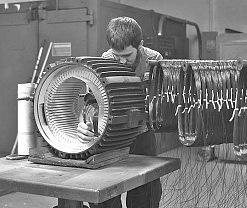




First full month of fall brings historic
By
Editor’s Note: The following climate summary was provided by the Wisconsin State Climatology Ofce.
October was another warm and dry month in Wisconsin, featuring summerlike temperatures and rapidly escalating drought conditions. October brought a wave of historic warmth, shattering late-season records.
In Madison, temperatures climbed to 82 degrees Oct. 29, tying the latest 80-degree reading on record — a benchmark set in 1937. Green Bay also made history that day with its latest 80-degree reading, nearly a full week later than its previous record in 1899 and a remarkable 30 degrees above average. The warmest temperature anywhere in the state this October was 86 degrees Oct. 11, recorded at the Boscobel Airport.
The rare fall warmth led right into Halloween morning. Bristol in Kenosha County was 71 degrees at 1:30 a.m., until a mid-day cold front dropped temperatures into the 30s and 40s statewide in the early evening when trick-or-treaters roamed the streets. With a statewide average temperature of 48.3 degrees, it was one of the warmest Halloweens in recent years. Wisconsin did not just see record highs during the day, either. Madison set records for nighttime warmth around Halloween, with unusually warm low temperatures of 65 degrees Oct. 29 and 64 degrees Oct. 30.
The month’s abundance of clear skies played a major role in this temperature pattern. Clear days allowed for more sunlight to heat the ground, while clear nights allowed for cooling. Hence, there was large maximum temperature departures from normal — 8.3 degrees above normal — but not as large as minimum temperature departures — 2.1 degrees above normal. However, Wisconsin also saw much cooler temperatures, with the state’s lowest temperature of 16 degrees Oct. 16 at Fort McCoy near Sparta.
By month’s end, temperatures averaged 52.0 degrees, 5.2 degrees above the 1991–2020 normal and the 12th warmest October on record. The past two months have been Wisconsin’s warmest September-October period on record at 58.0 degrees.
October was notably dry across Wisconsin, especially the rst three weeks of the month. The statewide monthly precipitation totaled only 1.71 inches, 57% of the normal 3.01 inches. Most of this rain arrived in the nal days of the month, leaving the majority of October exceptionally dry. Between Oct. 1-23, there were few days with measurable precipitation across the state. Madison had three days, Milwaukee had ve days, and La Crosse set a new record with no wet days at all. All told, 29 stations across the state reported no measurable rain for the entire rst three weeks of October.
By contrast, the nal two days of the month produced the lion’s share of precipitation over much of the state, especially the southern half, where a swath of heavy rain from 2-4 inches occurred from southwest to east-central Wisconsin Oct. 30 and 31. Several stations across south-central and southwest Wisconsin received 3.7 and 4.1 inches of rain within 24 hours. A station in Lafayette County near Cuba City set a 24hour maximum precipitation record of 3.80 inches, while Mt. Horeb in Dane County picked up a record 3.70 inches.
The Halloween storm system also delivered the rst measurable snowfall across Wisconsin, with 1-3 inches in the northwest
and a statewide high of 6.5 inches at Upson in Iron County.
The vast majority of Wisconsin continued the late summer-early fall dry spell throughout October. Precipitation totals were two inches or more below normal over most of the northern half of the state, especially in the northwest, where some locations received less than one-quarter of average October precipitation. The other comparably dry parts of the state were the far south-central and southeast regions, which sustained similar anomalies. The past two months represent Wisconsin’s sixth driest September to October period on record.
Drought conditions escalated throughout October, as shown in the U.S. Drought Monitor. Wisconsin began October with 30% of the state under moderate drought conditions and 8% in severe drought. By Oct. 29, 68% of the state was in moderate drought and the remaining 32% in severe drought. Furthermore, as of Oct. 29, Wisconsin, New Jersey and Delaware were the only three states in the entire U.S. that were entirely in drought, marking the very rst time in U.S. Drought Monitor history Wisconsin was completely drought-stricken.
This historical event sent the Drought Severity and Coverage Index to levels Wisconsin had not seen since September of last year, when the state reached peak annual drought conditions. On Oct. 31, the Climate Prediction Center released its seasonal drought outlook for Nov. 1 through Jan. 31, showing that drought is expected to remain in far southwestern and northern Wisconsin. However, drought is likely to end for the majority of Wisconsin. Wisconsin’s soils and streamows continued to show signs of lack of moisture. At the start of the month, most areas in the state had soil moisture levels within the upper meter at or below the 30th percentile, with a few counties dropping to the 10th percentile or lower. By the end of the month, conditions worsened signicantly, with many counties in the second percentile. While the lateOctober precipitation helped moisten the topsoil, it barely permeated 20 centimeters below the surface and did not reach to 40 centimeters.
As Wisconsin neared the end of the growing season, the U.S. Department of Agriculture’s National Agricultural Statistics Service Crop Progress and Conditions Report noted that Wisconsin consistently saw six days suitable for eldwork each week in October, thanks to the prolonged dryness. These conditions moved fall harvest quickly and helped farmers with planting cover crops, seeding winter wheat, spreading manure and fall tillage.
Soybean harvest was practically complete by the end of October, and corn for grain was two-thirds of the way there. Unfortunately, the warm, dry weather hindered pasture conditions. Additionally, the Wisconsin Wildre Dashboard showed that 198 res broke out in October and burned just over 1,000 acres, with 19 res reportedly related to tractors, mowers and brush hogs. Fortunately, the concerns that growers were having in September regarding inadequate soil moisture levels for fall-planted crops were lifted, as these crops emerged within a few weeks of planting.
The National Oceanic and Atmospheric Administration’s Climate Prediction Center’s outlook for Nov. 23 to Dec. 6 indicates Wisconsin will likely be warmer-thannormal. However, the precipitation outlook remains a mixed bag with slightly elevated chances for abnormally wet conditions in the state. Similarly, there is no strong signal for either temperature or precipitation between November and January. The exceptions are a slight lean toward warmer temperatures for southern and eastern Wisconsin and wetterthan-normal conditions to the northeast of Wisconsin.









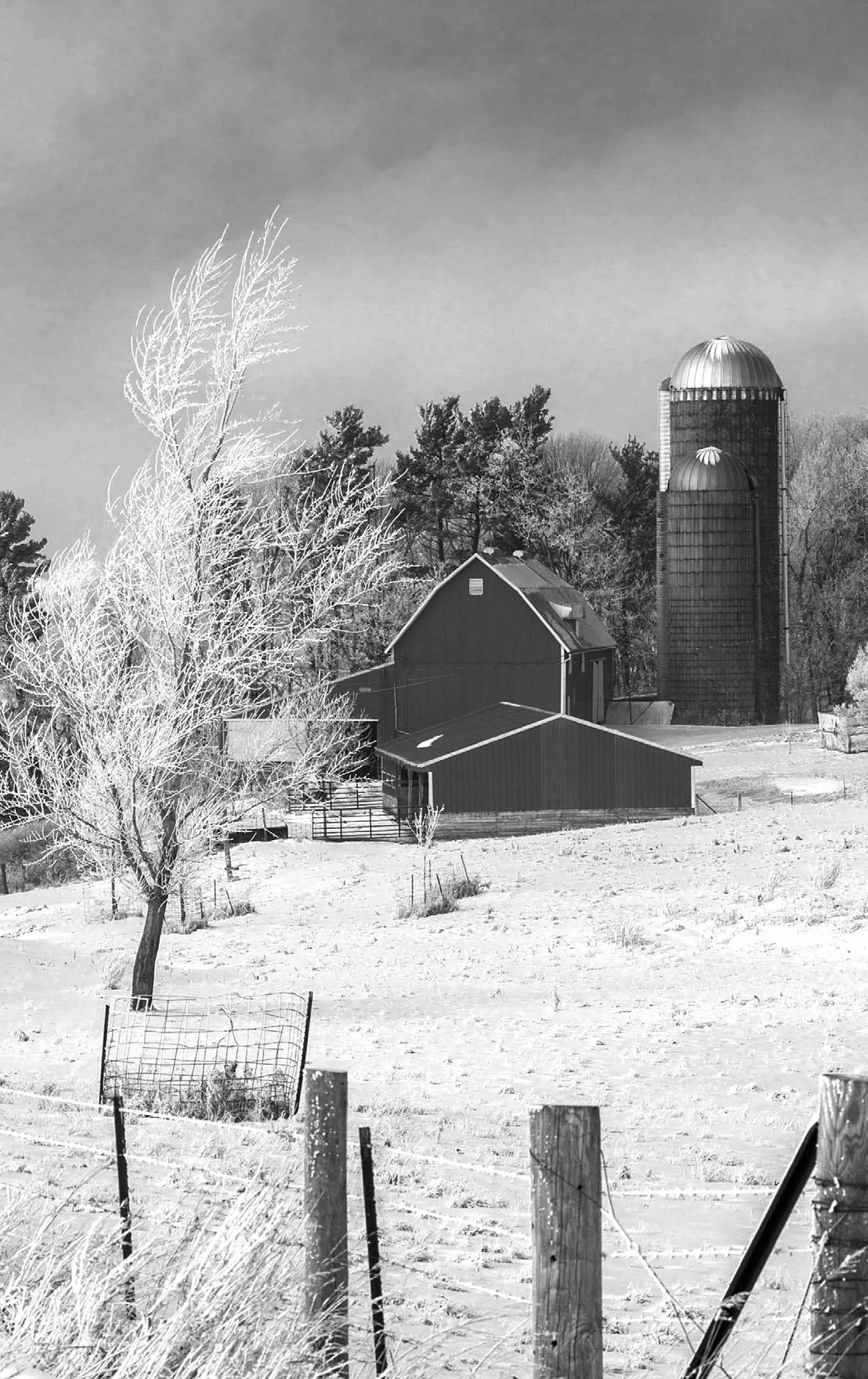
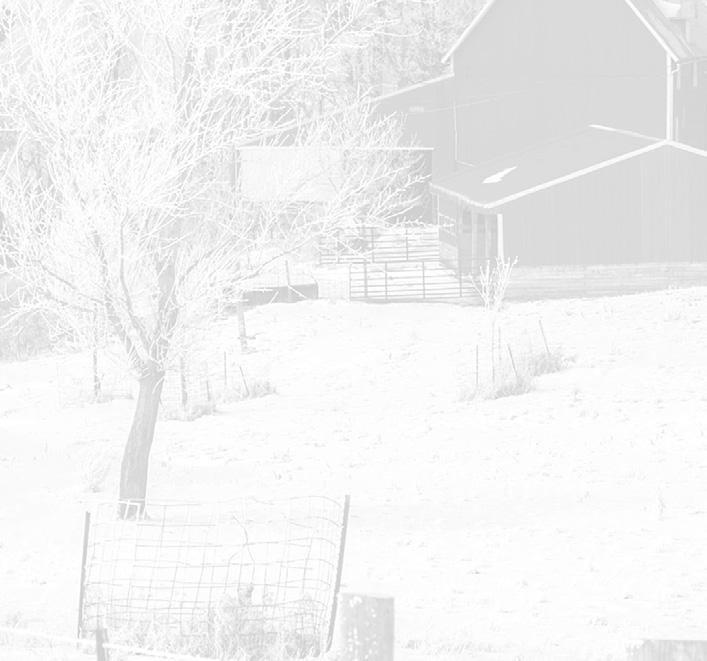







By Dan Wacker dan.w@dairystar.com
INDIANAPOLIS — Alaina Dinderman of Orangeville, Illinois, earned a pair of national honors at the National FFA Convention & Expo Oct. 23-26 at Lucas Oil Stadium in Indianapolis.
The senior from Orangeville High School took second in the Dairy Cattle Handlers Activity and was a national nalist for the National FFA Agricultural Prociency Award–Dairy Production Entrepreneurship. These are her rst national awards.
Students in the Dairy Cattle Handlers Activity present animals for evaluation as part of the Dairy Cattle Evaluation and Management Career Development Event. Handlers earn recognition for their ability to set up their assigned animal to its best advantage, maintain the animal in its most advantageous position, exhibit effective restraint and move the animal as requested by the event ringmaster.
Agricultural Prociency Awards honor FFA members who, through supervised agricultural experiences, have
developed skills they can apply to their future careers. For the Dairy Production Entrepreneurship competition, members own an enterprise or business and apply best management practices to efciently produce and market dairy cattle, including the raising of breeding animals for dairy purposes and products.
Dinderman was one of four to earn national nalist honors. She was joined by Summer Hammann of Barron, Wisconsin, Paige House of Preble Shawnee, Ohio, and Cade Claycomb of Trenton, Missouri.
In the dairy production prociency category, Dinderman created a ledger for her animals, tracking expenses and income and details of specic animals within her family’s herd.
“I have 15 animals in my record book,” Dinderman said. “Those are animals that I consider mine on the farm. They’re raised the same as the rest of the herd, I just keep a separate record.”
This was her fourth year entering her record book into the dairy production prociency award, and each year she’s nished better than the previ-

Ac�vity at the Na�onal FFA
dianapolis, Indiana. Dinderman won a pair of scholarships for her efforts in this ac�vity and the Dairy Produc�on Entrepreneurship event.
ous year.
“I’ve had a lot of people look over my record book

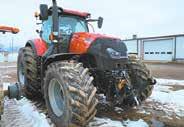
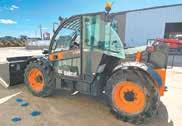




ture teacher at Scales Mound, so having advice from her and other ag teachers from the area was very helpful.”
In the Dairy Cattle Handlers Activity, Dinderman leaned on her family and experience showing cattle.
“I’ve been showing calves since I was 3,” Dinderman said. “I learned a lot of my showmanship skills through those experiences.”
Dinderman attributes her work ethic to the time spent on her family farm, which she thinks was a direct contributor to her success this fall.
“A big inuence on me has been showmanship and being involved in the dairy industry,” Dinderman said. “My parents did a great job of getting me involved in that. I also think my aunt was a big inuence on the prociency award. I wouldn’t have had the success I had without her and I’m really thankful to them (for guiding) me.”
Another element to her success was learning from new people. After qualifying for the national events, Dinderman went to the National FFA Convention & Expo before the rest of her Orangeville FFA Chapter.
since I started competing,”
Dinderman said. “My aunt, Lisa Oellerich, is an agricul-
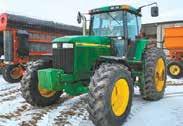




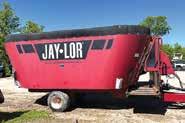







Con nued from DINDERMAN | Page 32
“I got to meet up with another chapter that was from New York,” Dinderman said. “I had known them from the past and they brought me in with their group. It was really fun to talk to and hang out with the New York kids. I was surprised how many of them lived on farms too.”
Part of that group that fostered Dinderman included Olivia Vanevera of the Cobleskill-Richmondville FFA Chapter, who was the winner of the Dairy Cattle Handlers Activity.
“It was great to compete with Olivia,” Dinderman said. “It was great to see the differences from our farms and the differences in breeds that we show. That’s one of the cool things about convention, getting to meet and connect with new people from around the country.”
The dairy industry has always been part of Dinderman’s life, but her experience in the competitions and her time at the convention have helped her put those experiences into perspective.
“I’ve been given a lot of opportunities that have had an impact on me,” Dinderman said. “Participating in those activities, making friends, expanding my network, helps you realize how benecial the dairy industry can be in someone’s life. … I can see the worth that the dairy industry has because others don’t get the experiences I have.”

At home, the Dindermans milk 60 cows in a tiestall barn. Alaina has a hand in many aspects of the farm but is especially part of feeding calves and the show heifers.
“I really like showing animals and watching the heifers grow up and become productive members of the herd,” Dinderman said.
Along with handling duties on her parents’ farm, Dinderman also plays basketball and softball at Orangeville
High School.
By winning the national awards, Dinderman earned scholarships she can use to help further her education. She is planning to attend Highland Community College and earn an associate’s degree before transferring either to the University of Wisconsin–Platteville or Virginia Polytechnic State University for animal or dairy science on a pre-vet track.
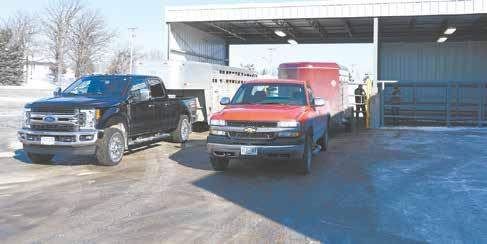
Long Prairie, MN Lean Cows

Dinderman shows a heifer in 2023 at World Dairy Expo in Madison, Wisconsin. Dinderman said her years of showing ca le gave her the skills needed to nish second in the Dairy Ca le Handlers Ac vity.
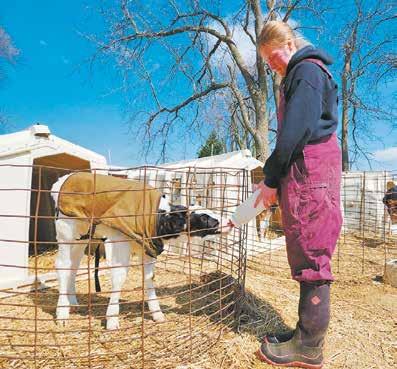

Yankton, SD Lean Cows
Mike Baczwaski • 800-445-0042 Gibbon, NE













By Steve Frericks Stearns County FSA executive director
It is truly impressive how quickly our ag community can harvest the crop and prepare for winter when conditions are right. The warm fall temps combined with limited weather interruptions made for one of the fastest harvest seasons on record. Be proud of what you have accomplished. Are you looking for some options to get those fall bills paid? Here are some resources below: Farm Storage Facility Loans
Everyone thinks the FSFL program is only for shiny new grain bins or hay sheds. This is not the case. What piece of equipment are you looking to upgrade on your farm? If it has to do with the handling of your crops, we invite you to check out this program. New or used, the Farm Service Agency
potentially can provide a loan for that piece of equipment. Semi-tractors, hopper bottom grain trailers, end dumps, live bottom, gravity boxes, grain carts, grain dryers, grain vacs, augers, chopper boxes and ag baggers are all examples of eligible equipment. Interest rates are currently between 3.75%-4% based on the term length and dollar value. Contact your local ofce for more details.
Marketing Assistance Loans
With harvest complete, FSA offers a 9-month commodity loan to provide interim nancing for eligible producers to help meet cash ow needs without having to sell your commodities when market prices are typically at harvest-time lows. Producers self-certify their current crop year bushels, which is veried against the acres reported to FSA in the spring. Producers can take out a loan against the bushels in their bins. When they are ready to market the grain, they simply notify FSA,










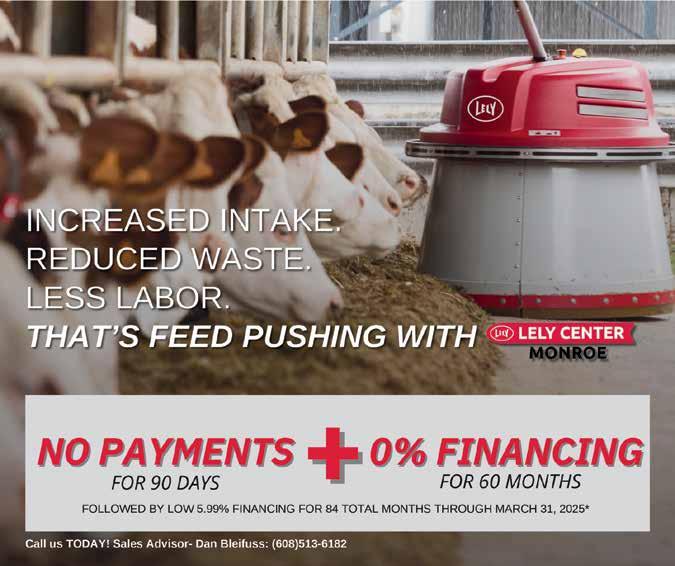
and we provide marketing authorization to the elevator you selected. When you are done hauling, the elevator sends FSA the amount owed to FSA and the balance to the producer. It is a very simple process. Remember this is a loan that carries an interest rate. The rate for November is 5.125%. Applicants are responsible for maintaining the quality of the grain under loan.
Each county has slightly different rates. Stearns County rates are as follows for 2024 grain:
— Corn $2.10.
— Soybeans $6.05.
— Oats $2.04.
— Barley 2.38.
— Spring Wheat $3.97.
AD-1026
Unseasonably warm temps are providing the opportunity to catch up on that laundry list of “rainy day” projects on the farm. If this includes opening up new land or xing tile projects, make sure you have completed form AD-1026 to allow for the proper review. This will help ensure your eligibility for U.S. Department of Agriculture program benets under conservation compliance rules.
Are you looking for options to start farming or a beginning farmer looking for assistance to begin a farm operation? Are you a farmer planning to retire and looking for options to transfer the farm, or an existing farmer having nancial difculties? It can be a challenge trying to determine where to start or how to learn about options. The FSA may have a loan option to assist you. An excellent place to start is the FSA Farm Loan Discovery Tool or the Farm Loan Assistance Tool. This can be found on the Farmers.gov website under Loans. You can also contact your local FSA ofce to review the programs or discuss any questions that you may have.
FSA offers direct farm ownership and direct farm operating loans to producers who want to establish, maintain or strengthen their farm or ranch. Direct loans are processed, approved and serviced by FSA loan ofcers.
Direct farm operating loans can be used to purchase livestock and feed, farm equipment, fuel, farm chemicals, insurance, and other costs including family living expenses. Operating loans can also be used to nance minor improvements or repairs to buildings and to renance some farmrelated debts, excluding real estate. Direct farm ownership loans can be used to purchase farmland, enlarge an existing farm, construct and repair buildings and make farm improvements.
The maximum loan amount for direct farm ownership loans is $600,000. The maximum loan amount for direct operating loans is $400,000 and a down payment is not required. Repayment terms vary depending on the type of loan, collateral and the producer’s ability to repay the loan. Operating loans are normally repaid within seven years and farm ownership loans are not to exceed 40 years.
Please contact your local FSA ofce for more information or to apply for a direct farm ownership or operating loan.
Farm Service Agency is an equal opportunity lender. Complaints about discrimination should be sent to: Secretary of Agriculture, Washington, D.C., 20250. Visit www.fsa.usda.gov for application forms and updates on USDA programs





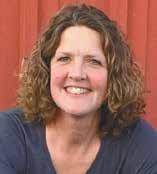
By Tina Hinchley Farmer & Columnist
I have been sharing my life story with the readers of Dairy Star for many years. I remember when Mark Klaphake, the general manager, asked me to write and share my stories with farmers at World Dairy Expo. I was walking around with my family and stopped by the Dairy Star booth to mention how much we really enjoyed reading the Dairy Star. My daughter, Anna, was with us and Mark asked her too if she would write about what it is like being a young farmer wanting to continue working in agriculture. It really took some serious thinking to commit to writing. It takes time and often I don’t have enough to do the best I can. Hosting dairy farm tours for over 27 years now has given me many ideas for stories. Writing about topics that I really have passion for is easy. But many times, it is just like everyone else in farming, and who cares to read about the same old thing. I try to spice it up a bit, with silly farm tour things, like the crazy things that children say and even when parents acknowledge that they had weird and wacko thoughts about what they thought farming was about. Those stories are easy to write about.
Opening my barn doors for visitors is one thing, but to share with readers and keep it going can be challenging. So, I wrote about my fear of going to the dentist. I had many readers email to sympathize with this fear. They laughed with me about the panic sweats that they too get just by opening the ofce door and smelling the dentist ofce smell.
I also told about my experience going to the doctor’s ofce to only have the doctor not realize that when a farmer comes in to see them something is really wrong. We farmers don’t waste our time going in for a cold or u. Whatever we go to the doctor for, it has to be bleeding profusely or cause severe pain. I didn’t have time to chit chat about a reality TV show about a farmer because that isn’t real. I didn’t need sympathy for being a farmer, I wanted to have my issue addressed. The feedback from this column was very similar. We farmers don’t have time to waste. We want to get xed so we can get back to farming.
I wrote about my relationship with my mom. She was never a loving kind of mother. I really wished she could have been a better grandmother to my children. She could not meet my expectations for wanting her to help with my twins when they were newborns or at any time while she was alive.
This topic really helped me to write about my feelings, almost like a counseling session, to force me to look at why I wasn’t sad when she died. But it is OK, because I am a better mother because she showed me what not to do. I am condent my mothering and grandmothering skills have soared far beyond anything she could have achieved. This topic hit many other readers too. It is hard to say I don’t like or even love my mother. Conding in a common topic makes it easier to realize that it isn’t our fault our mothers were not good mothers.
I have written about what it takes to make Wisconsin America’s Dairyland. Along with the beautiful family farms, cows and amazing dairy products, we have to be thankful for our employees who help milk cows, feed calves, scrape and clean pens, and do the eldwork that we could not possibly do ourselves. Many of these employees are not the high school or college students that we were able to hire in the past. They are the people that have traveled far to work for us. Some have brought their family in tow, escaping fear, hunger or unbearable conditions to work alongside us to help us be the dairy farmers that make up Wisconsin’s Dairyland. They also work in the factories making cheese and other dairy products. Our meat processing would not be complete without their help. They were the essential employees that showed up during the coronavirus pandemic. They are our workforce. They help us in every imaginable area where there aren’t enough employees.
As we headed into this election this month, I was open and honest with my feelings about where I stand on many things. I even stepped out and participated in helping candidates by doing a television video to show our support. I believe that helped others realize that we are not red or blue. As farmers, we should be purple. Different things affect our families in different ways. Some things are good for our family and others are not. Advocating for a person who has always been for Wis-
consin and all farmers throughout the U.S. was my main intention. Both Farm Bureau and National Farmers Union members supported the candidate. I am thrilled to be able to help with that outcome.
The other commercial that I did was about making sure everyone has the healthcare we need to continue farming. The Affordable Care Act is a big deal to hundreds of thousands of people who would not otherwise be able to get healthcare with a pre-existing condition. I had phone calls, emails and visitors come from far and wide to thank me for doing this advertisement. I ended up putting myself as the target for others to embrace or to criticize about the candidate that I was endorsing. I knew what I was doing, and I would do the same thing all over again. I am hopeful with all the others with preexisting conditions that the ACA is going to be a choice for us in the future.
As I nish this last column to the dairy farmers that



I have shared my stories and my life with these many years, I hope you have a plan for the future. I hope you have enough help if your immigrant farm workers have to leave. There are not enough robots to help milk the U.S. dairy industry’s cows. I hope you have a plan for your crops if the tariffs make our commodities too expensive for other countries to purchase. I hope you have a plan for your future if the Social Security benets are tapped into. What is the course to take regarding your family if your mother, wife, daughter or granddaughter needs medical attention and help if something terrible happens to them? I don’t know what I am going to do. Do you?
Tina Hinchley, her husband Duane and daughter Anna milk 240 registered Holsteins with robots. They also farm 2,300 acres near Cambridge, Wisconsin. The Hinchleys have been hosting farm tours for over 25 years.

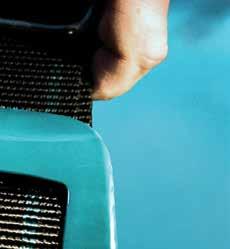






www.genex.coop/herdmonitor







Last week during guidance class in Cora’s second grade, they discussed gratitude. She came home, and being her mother’s daughter, grabbed a pencil and paper and began writing. She begged chores off that night because she needed time to write. How could I say “no” to that?
As I was thinking about what my column should be about, and the approaching Thanksgiving holiday, I pondered for a moment writing a poem about all the things I am thankful for. Then I gured that reading a 7-year-old’s list of things she is thankful for might be more exciting.
I asked her permission to use her “gratitude book” as my column, and she happily obliged. I am also leaving her spellings as they are written, with a bit of help for those who may not be as procient in deciphering children’s writing. I think sometimes as adults we think too hard about things to be thankful for, when in reality, the simplest ones are pretty



great.
— I am thankful for Henry and Dane and Finley because they let me play with them.
— I am thankful for my toy cows, horses, sheep, chickens, goats, dogs, barns, and cars.
— I am thankful for Tassia because she let me go to her house.
— I am thankful for Uncle Tony because he was in the war.
— I am thankful for Aunt Sherry, Jadyn, Piper, Kendall, Jessa, Shaelynn, Whitlynn, Cole, Clayton, and Garrett because they help make lefse at the farm.
— I am thankful for my family because we get two turkeys for thanksgiveing.
— I am thankful for the hunters because they get to go hunting.
— I am thankful for Arabella (new red and white calf) because she is outside so she will be alive.
— I am thankful for my lego set because it helps

me bild a pikcher (picture) of Ferdnand (Ferdinand the bull).
— I am thankful for the bin in my house because it is full of legos bilt.
— I am thankful for books because they give us informashane (information).
— I am thankful for my toy room in the farm house.
— I am thankful for Sophia (a friend) because she gets to go to her Gramas on Fridys.
— I am thankful for Hailey (a friend) she gets to go home right away.
— I am thankful for Stasy (Stacy) because she let me got to her house.







By

— I am thankful for Oliver because he helped me work on the farm.
— I am thankful for Peter and Linze (Lynzie) they let me go on a (horse) ride with them.
— I am thankful for Daylily (show calf) because she is helthey (healthy).
— I am thankful for silens (silence) to write.
— I am thankful I get to go to the cabin.
— I am thankful for a good book to read.
— I am thankful for my mom because she feeds me every day.
— I am thankful for a bed that is warm. I am thankful for a warm home.
— I am thankful for a warm blanket at night.
— I am thankful for Pa because he makes pancakes, wafes, and crepes.




— I am thankful for Ira because he hauls cattle.
— I am thankful I have a farm.
— I am thankful for a warm blanket at night.
— I am thankful for Stella because she milks cows at the farm.
— I am thankful for Garrett because he helped me move calfs.
— I am thankful for by barbeys (Barbies) because I can allways play with them.
— I am thankful for Lyla because she plays with me every day.
I hope you and yours have a wonderful Thanksgiving holiday and a safe hunting season. May your plates be full and your meat hooks strong. I am thankful for all of you who read my wild writings year after year. Take care, dear friends.
Jacqui Davison and her family milk 800 cows and farm 1,200 acres in northeastern Vernon County, Wisconsin. Her children, Ira, Dane, Henry and Cora, help on the farm while her husband, Keith, works on a grain farm. If she’s not in the barn, she’s probably in the kitchen, trailing after little ones or sharing her passion of reading with someone. Her life is best described as organized chaos, and if it wasn’t, she’d be bored.



Milk components have been high the past couple of months — higher than normal seasonal values — yet many herds continue to search for additional pounds of milk. Producers may focus on the volume of milk shipped on a cow or herd basis when, in fact, it is the pounds of solids that leave the farm that ultimately pay the bills.

By Barry Visser Nutritionist
The Federal Milk Marketing Order 30 applies to most Dairy Star readers. Pay price within the FMMO 30 on milk protein climbed above $3 per pound in October for the rst time since 2022, settling at $3.32. Butterfat had been the majority contributor for quite some time, but it dipped in October, settling at $3.09 per pound. As we watch the ebbs and ows in fat and protein prices, it is a clear illustration of the inuence milk solids have on mailbox pay price. The volume contribution of fat and protein still comprises most of the value the milk check.
Because of the value of milk components, many herds track combined fat and protein pounds shipped on a per-cow basis. Target goals are herd specic. Some high-performing herds produce more than 7.5 pounds of combined fat and protein. It is important to calculate this number for your herd and use this as an internal benchmark for improvement.
Energy-corrected milk is a calculation that factors in the pounds of fat and protein shipped. This measurement is more valuable than looking at milk volume alone or even fat-corrected milk. For example, a herd milking 85 pounds of milk with 4.1% fat and 3.3% protein would yield an energy-corrected milk value of 94.4 pounds. If milk production increased by 5 pounds per cow to 90 pounds of milk, but components dropped to 3.8% fat and 3.0% protein, this dairy would ship the exact same pounds of solids.
Inconsistent feeding time or variation in feed distribution can impact meal patterns and promote slug feeding. Cow comfort and stocking density can negatively impact resting time. Heat abatement strategies are critical to success in the summer and can promote more consistent intakes and cow comfort. Manage these factors to support milk fat production.
Nutritionally, certain levels of effective ber are necessary to promote cud chewing and rumination. Particle size and digestibility of forage ber impact total intake of neutral detergent ber. Adequate forage NDF intake relates directly to rumen pH, and rumen pH is linked to milk fat. A healthy rumen environment minimizes wide uctuations in rumen pH through balanced carbohydrate nutrition, which leads to the formation of more acetate and butyrate, which are volatile fatty acids that serve as precursors to milk fat.
Too much vegetable oil has been shown to negatively impact milk fat. As wet corn sources move further into fermentation and starch becomes more available, so does some of the corn oil within the kernel. This can also cause some challenges to milk fat as we move closer to summer.
Research conducted by Dr. Kevin Harvatine at Pennsylvania State University has demonstrated the value of rumen-available methionine sources to milk fat synthesis. Rumen-inert fats high in palmitic acid have been shown to have a positive impact on milk fat. Feeding elevated levels of sodium and potassium or rumen modiers, such as yeast and direct-fed microbials, can be benecial in improving milk fat.
The concept of amino acid balancing is nothing new to the dairy industry. Lysine and methionine are the two most limiting amino acids in a lactating dairy cow diet. Feed ingredients, as well as synthetic sources, can contribute lysine and methionine to the diet. However, not all sources are created equally. The bioavailability of these amino acids — and the decision of which feedstuffs provide the most economical return on investment — is a conversation to have with your nutritionist.
The primary goal with amino acid balancing is to improve protein efciency. As a result, amino acid balancing often yields an improvement in milk protein output. Improvement in protein efciency also results in less nitrogen excretion, which inherently has environmental benets. Lower nitrogen excretion also results in additional energy that can be utilized for body reserves, milk production or other requirements of the cow.
Increasing pounds of milk isn’t necessarily the best way to build up your milk check. Work with your feed team and nutritionist to evaluate feed ingredients and management factors that may contribute to greater milk components. The net results can be improvement in cow health, performance and an economic return to your bottom line.



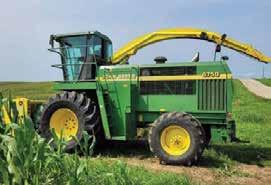










................ $552,900
JD 9600 2020 Kernel Processor, PRWD, 1344 hrs., 775 hrs., #565393 ............... $375,000
JD 9600 2019, Kernel Processor, PRWD, 1321 hrs., 866 hrs., #532049 .............. $369,900
JD 9600 2019, Kernel Processor, PRWD, 1755 hrs., 1130 hrs., #553763 ............ $329,900
JD 9700 2021, Kernel Processor, PRWD, 1412 hrs., 900 hrs., #579477 .............. $454,900
JD 9700 2020, Kernel Processor, PRWD, 977 hrs.,
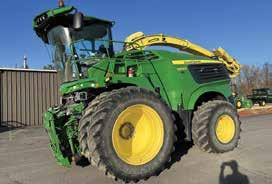




It feels like we have been running against the wind these past few weeks trying to complete the harvest marathon. The fall season has lingered a bit longer than expected, creating opportunities and difcult decisions.
We have been extremely dry here in central Minnesota. It has been almost four months since we have had a rain total of more than an inch. The dry conditions and limited number of warm days left on the calendar have pushed us to pass on seeding some extra cover crops on our sandy soils. There just didn’t seem to be enough time or moisture. We could have turned on a pivot to kick-start the rye growth but the lines were already blown out for the coming winter season. The calendar said it was time. The weather had a different timeline. We didn’t need to pay that bill twice. So we had to punt

on that idea for now.
The dry conditions have made it hard on the tillage equipment this fall, too. Recent sprinkles have helped to loosen the dry grip on the land so Mark could work down the corn stalks. Worked elds mark the end of a growing season, a job completed. It is like the nal chapter in a long novel.
Breakfast conversations have been focusing on the shifting conditions and operational options with an extended fall season. Soil tests and corn test plots results have been studied, discussed and plans made for which elds need extra attention to be ready for another growing season. The biggest question is, “Is there enough time before the snow ies?”
With the extended fall season this year, we have been able to get a few more things checked off the
to-do list. All the equipment had been stored away in the shed before we had to pull out the insulated coveralls and gloves. I was a bit surprised though when Mark came driving into the yard with the snowblower swinging in rhythm to the three-point hitch. Did I miss a weather forecast or was he daring Mother Nature? Neither. He just didn’t want it buried behind stored wagons to dig out later.
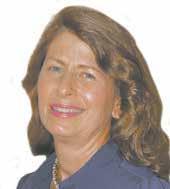
By Natalie Schmitt



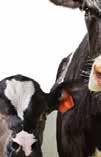













Joelle and Austin have taken charge of my garden for the coming year. My little patch of dirt has never been a high priority for fall tillage work. To be honest, I never really ever had it completely cleaned out before the snow fell either. With the kids in charge, that is a completely different story. Austin expanded and worked up the garden so they could plant 2,000 cloves of garlic. By the beam of the truck headlights, they were able to get all the cloves planted and bedded down under a blanket of straw. Spring bulbs will also have to be buried before the snow ies as they expand their cut ower business.
As we wrap up another fall season, it pushes me to muddle through thoughts oating around in my mind. Your mind can’t help but wander as you drive around in circles going nowhere as stalks are chopped or soil is cut open with sharp chisels, occasionally disrupted by the discovery of a buried boulder just below the surface.
It starts with a simple thought, “We grow crops, but we raise kids.” We provide both with all that they need to reach their potential. We (as farmers and parents) do not have absolute control over how things turn out, despite our best efforts. Fall is the time to review how the journey is going.
It is hard not to be overly critical of the decisions you’ve made. That is why they say hindsight is 20/20. You can only make the best decision at the time with the information at hand. A few extra prayers can’t hurt either.
If no one comes back to the dairy, have we failed as farm parents? Some may say a lack of expansion, diversity or business evolution is to blame. It is hard to sort through these negative thoughts, but I pause and think about the real focus. Our goal in life was to raise a family who laughed with and loved one another. We didn’t want to milk lots of cows. We did want to develop good cows who could provide for our family’s needs. We wanted our kids to nd their own dreams and not feel they had to follow or nish our dreams. By these standards, I can say we are heading in the right direction. All are still involved in the dairy in their own unique way.
It’s not what you do that determines success. It’s who you are: faithful, committed, determined, compassionate, humble, honest. That is how success is measured.





The weather forecast this week says we have run out of time. The marathon is done. As the temperatures plummet to new low daily highs and the snow starts to swirl around our feet, we can nally put this growing season to bed and call it a wrap.
As their four children pursue dairy careers off the family farm, Natalie and Mark Schmitt started an adventure of milking registered Holsteins just because they like good cows on their farm north of Rice, Minnesota.

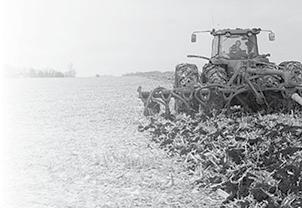

“What you get by achieving your goals is not as important as what you become by achieving your goals.” – Zig Ziglar
Back in August before the start of the Minnesota State Fair, I asked Dan and Monika about their goals for the fair. They each had several goals, but one goal topped the rest: do well enough in the state 4-H dairy judging contest to earn a spot on the dairy judging team that represents Minnesota 4-H at the NAILE Youth Dairy Judging Contest in Louisville, Kentucky. Minnesota 4-H sends a composite team of the top four judges who aren’t part of the rst or second place teams.
team, met us at the contest. We enjoyed visiting a couple dairy farms along the way for judging practice and plenty of Culver’s fresh frozen custard.
Dairy Good Life

For Dan, this was a goal held over from last year’s state contest. After judging at World Dairy Expo in 2022, he was eager to judge at another national 4-H contest. But, as anyone who understands dairy judging knows, success in dairy judging comes partly from skill and partly from luck. The stars didn’t align for him in the 2023 state contest.
The Saturday morning contest went well. It was neat to see the green shavings again; I judged in Louisville as a 4-H student, but I haven’t been back to the show since then. Monika said she got a bit nervous right before her rst set of reasons, but was able to shake it off before the next three sets. I reminded her that being nervous at a national contest is completely understandable. Dan saw the classes a little differently than Monika and I did, but said he felt condent.


By Sadie Frericks Columnist
While his eligibility to judge in Louisville doesn’t end until next year, the goal of making the team felt a little more urgent this year. Dan also has a goal of competing in the National FFA Dairy Cattle Evaluation Contest in 2025, inspired by his team’s second place nish at the state contest last spring. But NAILE has a longstanding rule that prohibits 4-H students and FFA students from competing in both a national contest and NAILE in the same calendar year. So, earning a spot on the Louisville team this year would prevent the need to choose between contests next year.
Monika wanted a spot on the Louisville team for a similar reason. This is her rst year judging at the senior level, so she has several years to qualify for the Louisville team. But, she’s on the same FFA dairy cattle evaluation team as Dan, so with any luck, she’ll go to Indianapolis, Indiana, next year. After that, she has her sights set on helping her county team earn a spot in the National 4-H Dairy Judging Contest in Madison, Wisconsin.
Both Dan and Monika also felt it would be special to judge at a national contest together. And since Dan has already judged at Madison and is ineligible for Harrisburg, the contest at Louisville was their only opportunity. Let me pause for a moment here to say that seeing my kids encourage each other and want to compete together makes me incredibly happy.
When the state contest awards were announced, Dan and Monika had both secured a spot on the Louisville team. So, two weeks ago, we set our compass for Louisville. We picked up Kevin, my fellow coach, and Garrett, another 4-H student named to the team, along the way. Tyler, the nal member of the
It was a bit nerve wracking to wait until the Sunday morning awards breakfast to nd out how everyone did. The goals for this contest were less clearly dened – more along the lines of “do well.” And, truly, judging at a national contest is an honor in itself; earning an award at a national contest is like the cherry on top of the sundae.
As it turned out, the stars aligned and all their practice paid off. Dan placed fourth in reasons, fourth overall, fourth in Holsteins, and eighth in Brown Swiss. There was actually a four-way tie for rst in reasons, but the tie was broken based on lowest placings scores in reasons classes. Dan placed the reasons classes best, so he ended up fourth. Monika placed seventh in reasons, twentieth overall, rst in Brown Swiss, and rst in Jerseys.
As a team, Minnesota 4-H was rst in reasons, third overall, rst in Brown Swiss, rst in Holsteins, and top seven in every other breed. It was pretty cool that everyone on the team went home with a couple ribbons, some hardware, and a couple breed gifts.
As a coach, the award I am most proud of is the blue ribbon each team member received for winning team reasons. In dairy judging, kids and coaches don’t always place classes the same way the ofcials do; we each have individual biases and priorities. But in reasons, there’s less subjectivity. Defending your placings better than everyone else in the contest is an incredible accomplishment.
I think it’s fair to say they “did well.” Goals were set and goals were met. And in striving to reach those goals, these kids have developed skills that will serve them well for the rest of their lives: the ability to remain calm under pressure, make critical decisions quickly, and then condently explain those decisions. It truly isn’t about what they got, but what they’ve become.
Well done, kids.
Sadie Frericks and her husband, Glen, milk 100 cows near Melrose, Minnesota. They have three children: Dan, Monika and Daphne. Sadie also writes a blog at www.dairygoodlife.com. She can be reached at sadiefrericks@gmail.com.


















